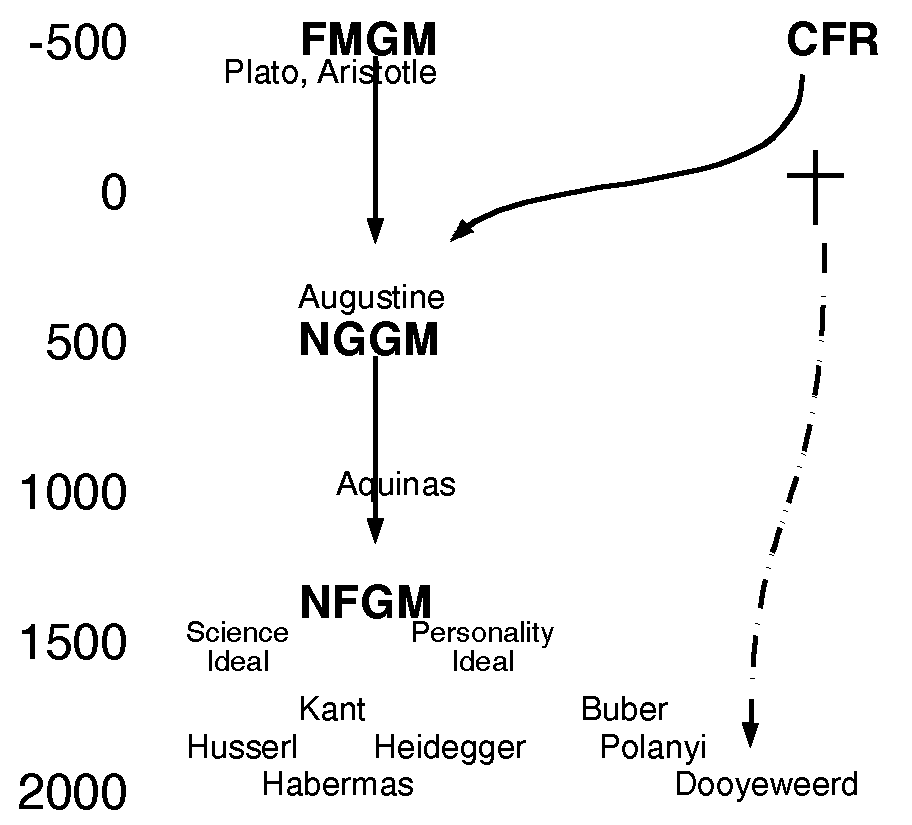

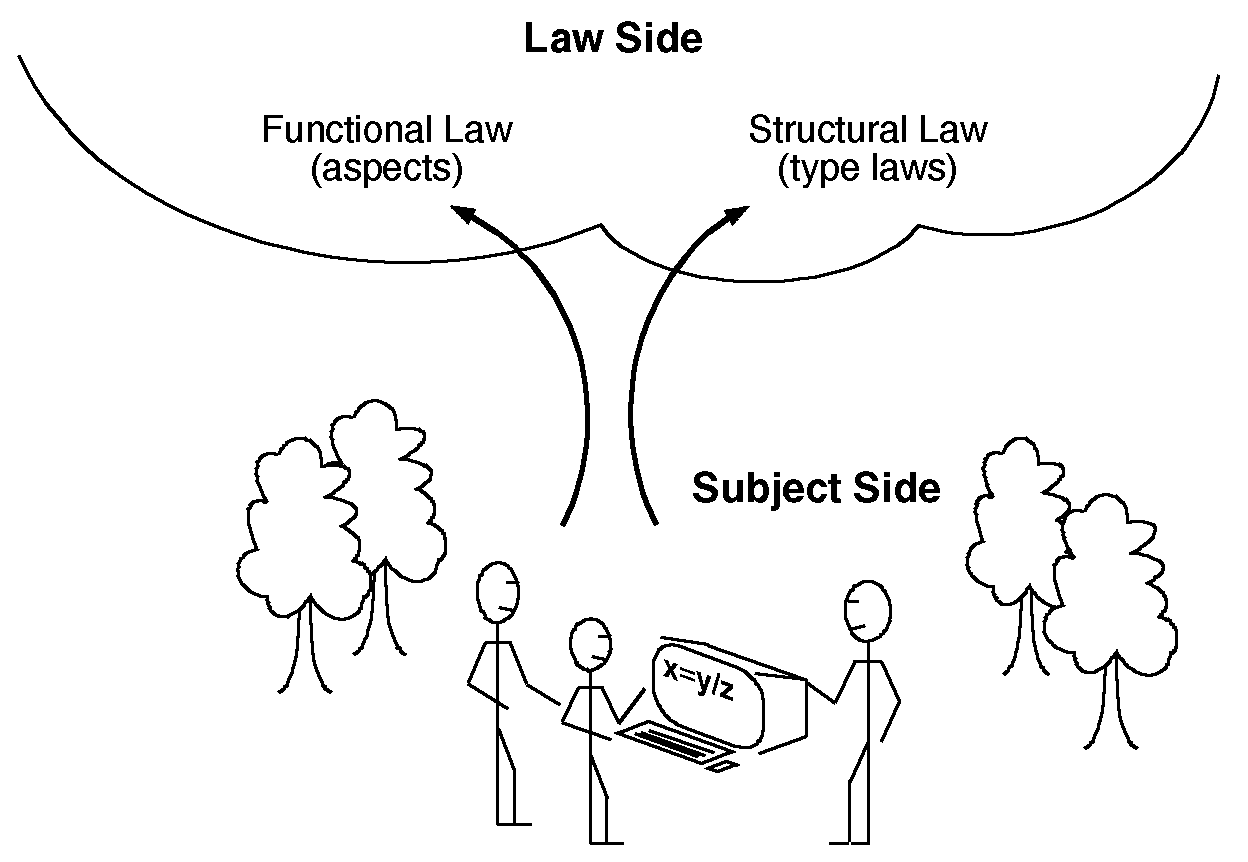
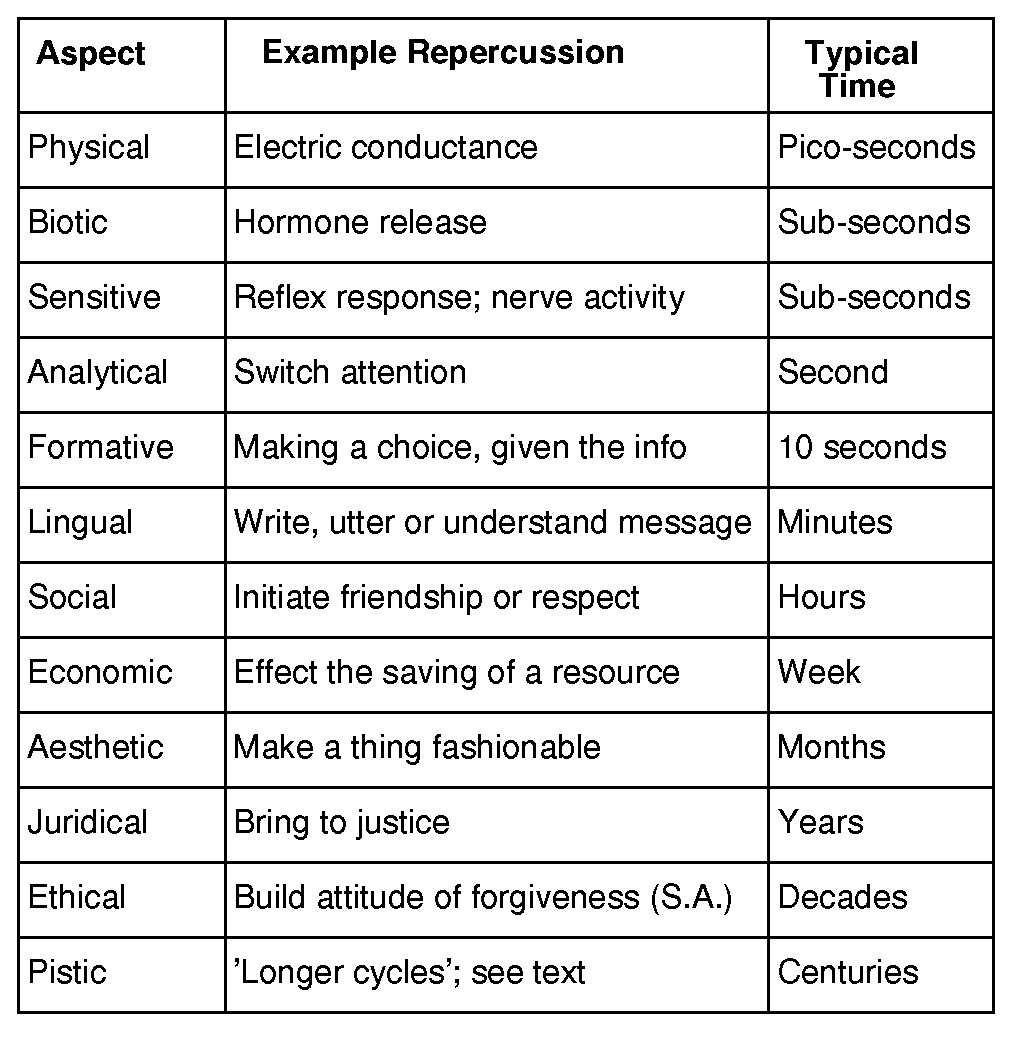
The following gives examples of aspectual functioning in writing a book; notice how many aspects are involved ('see text' refers to text of my forthcoming book:
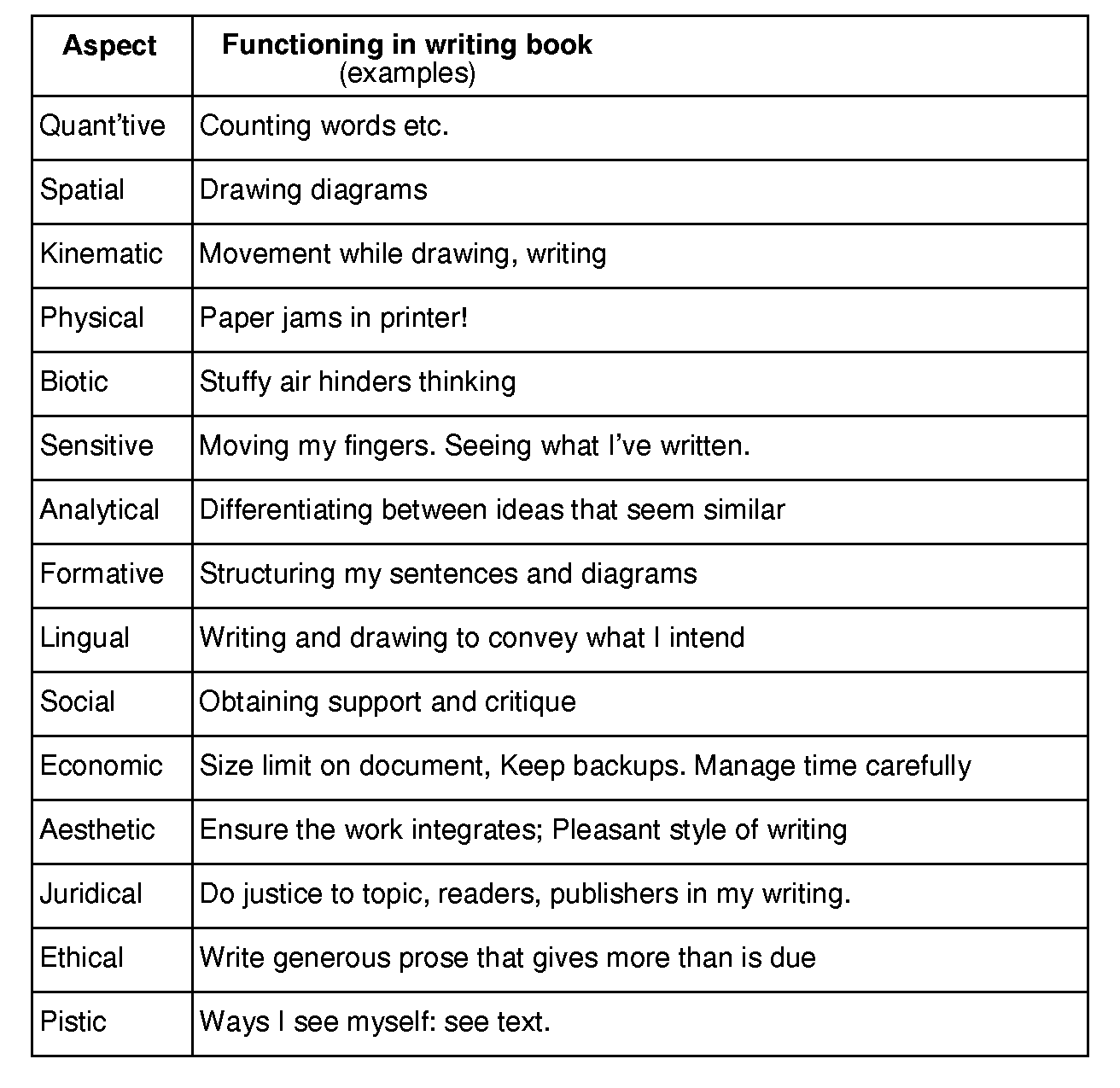
The following gives examples of anti-normative functioning ('dysfunction') in each aspect:
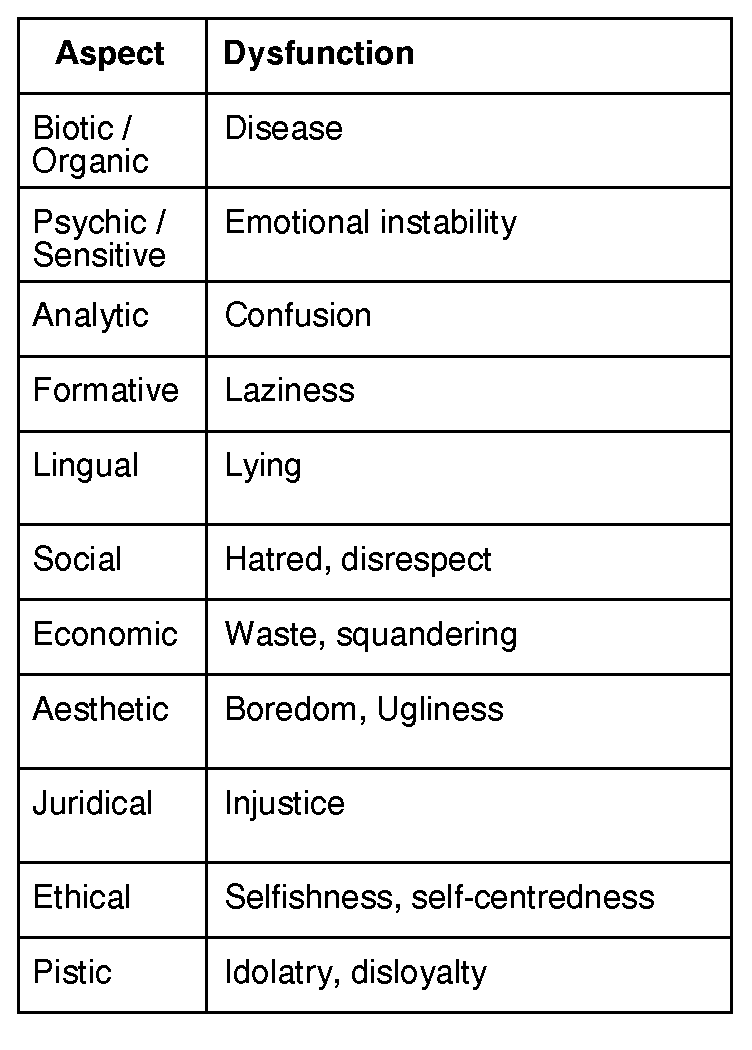
The aspects could be taken to define what it means to be 'fully human':
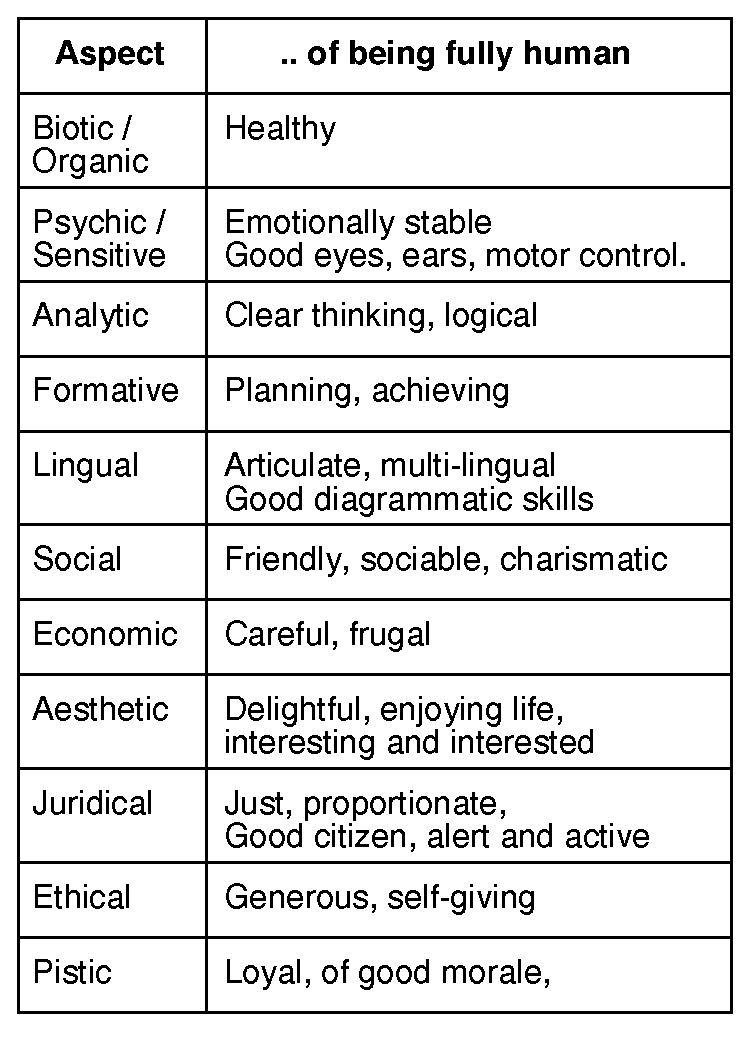
The aspects provide many different ways of knowing; what we usually think of as theoretical or analytical knowing, which produced theory, is only one of these (the analytical aspect). We can see one type of intuition as knowing that involves all aspects in harmony. (Note also that this enables Dooyeweerd to engage positively with feminism in its call for multiple ways of knowing.):

The following gives examples of 'things' of our experience that are qualified by each aspect (that is, in which the given aspect is of special importance in determining its meaning):
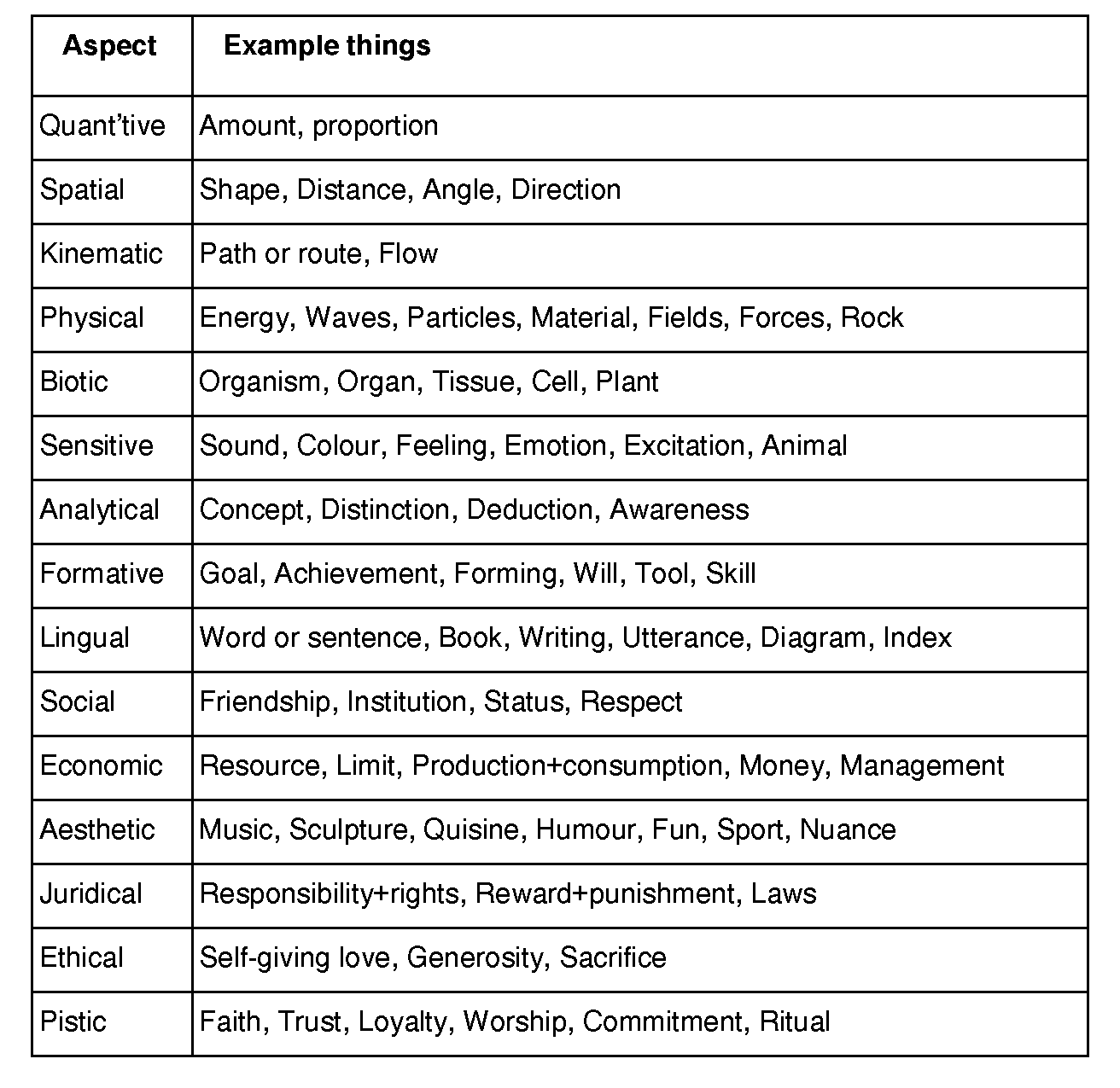
The following gives a list of some of the sciences that centre on each aspect:
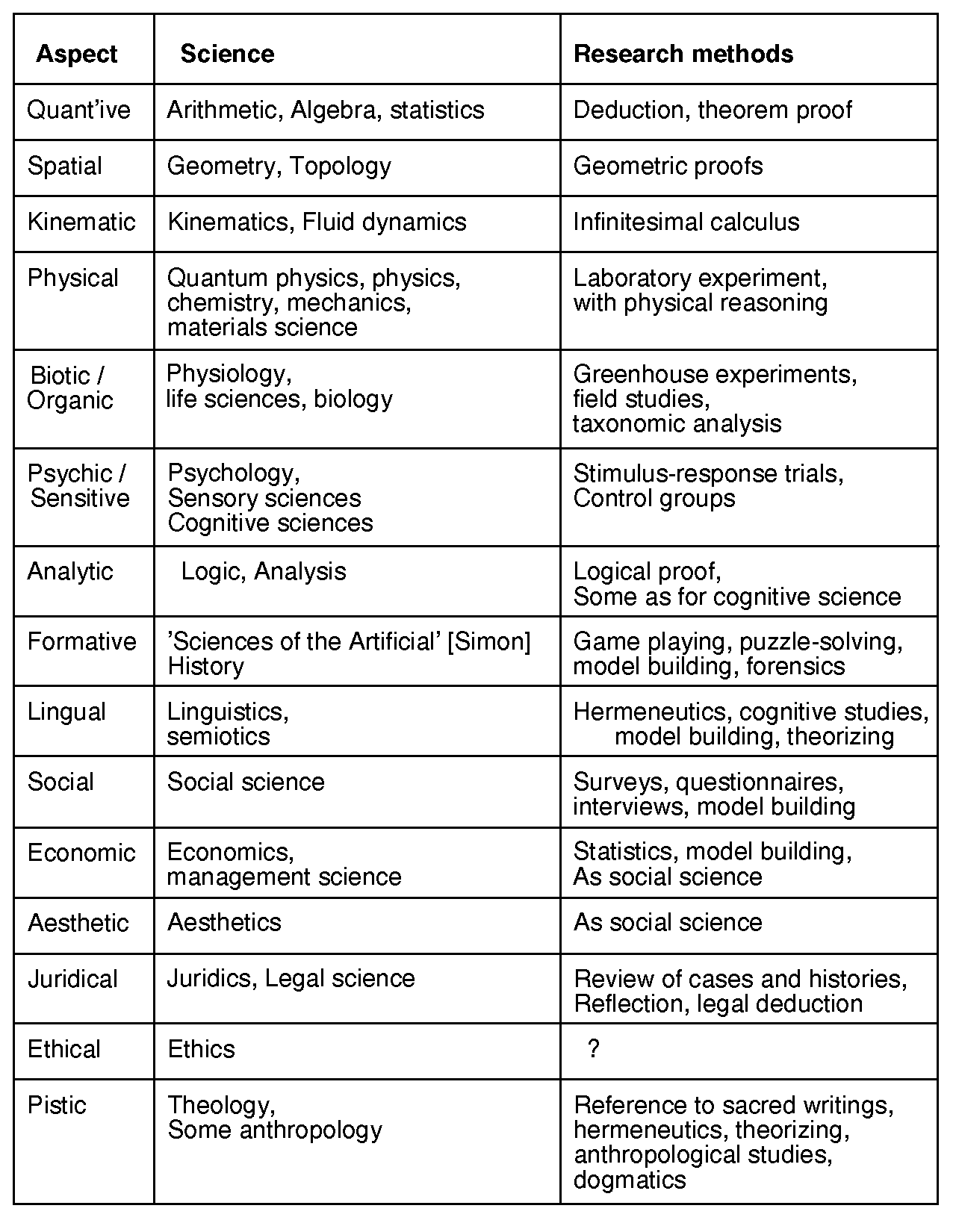
The following compares Dooyeweerd's suite of aspects with some others. A fuller, and growing, comparison may be found in Comparing Suites.


If we apply this in more detail, in the foundational (retrocipatory) direction, and focus on dependency rather than inter-aspect analogy, we find that each aspect depends on earlier aspects foundationally. Both directly (e.g. social depends on analytic aspect when we distinguish one person from another) and indirectly (e.g. social depends on analytic via lingual when we distinguish sounds as being speech):
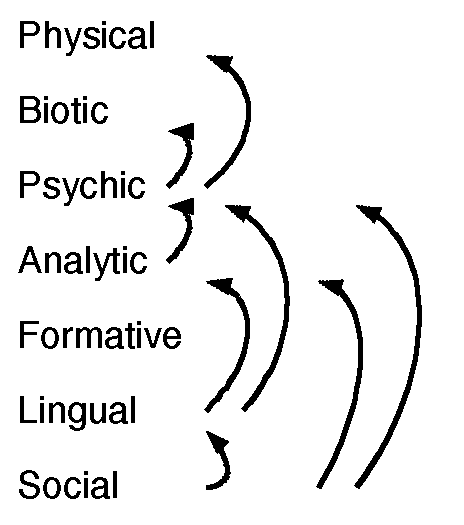
In addition to anticipating or retrocipating the others, each aspect also 'reaches out' to all the others. Those shown are the analytical, which enables us to make diverse types of distinction, and the lingual, which enables us to express diverse types of meaning in symbols:
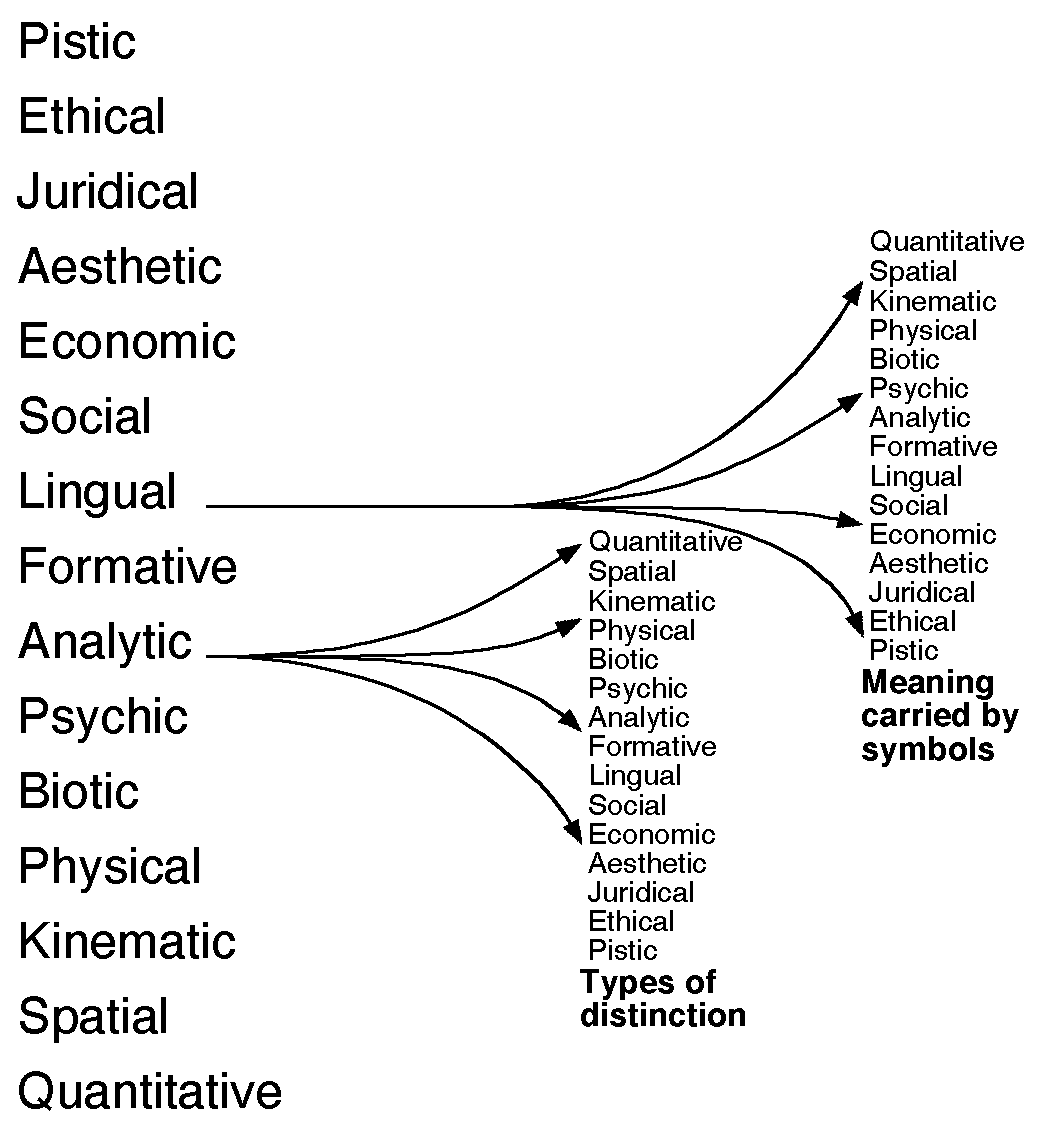
The kernel meaning of the analytical aspect is to make distinctions. This can be of a thing from other things, or of 'me' from the rest of the cosmos:

Dooyeweerd's notion of subject and object is very different from notion we inherited from Descartes (see example of human-computer interaction below):
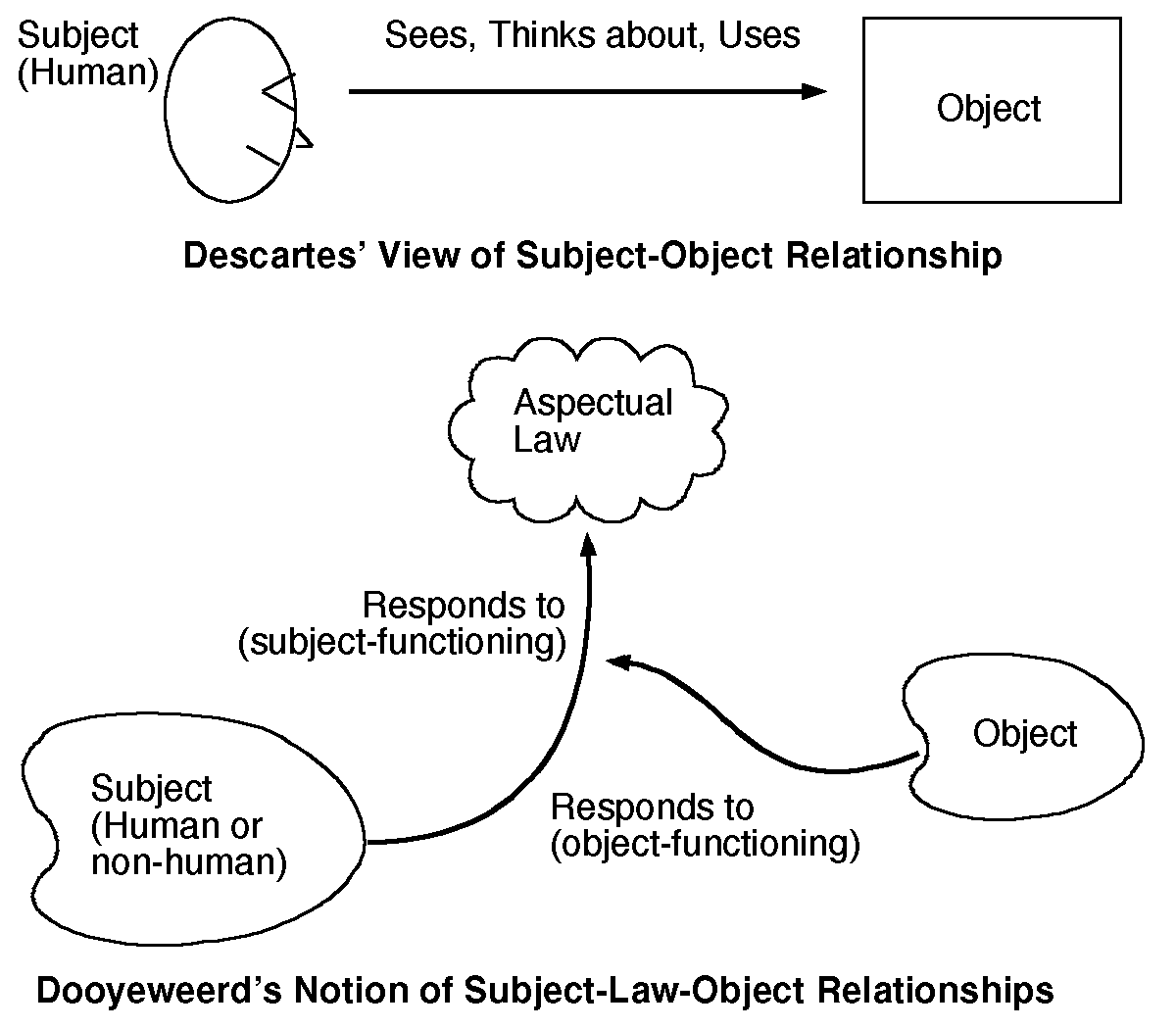
Both Heidegger and Dooyeweerd were critical of Descartes. Their views show many similarities, but also some differences (see also fuller comparison with Heidegger:
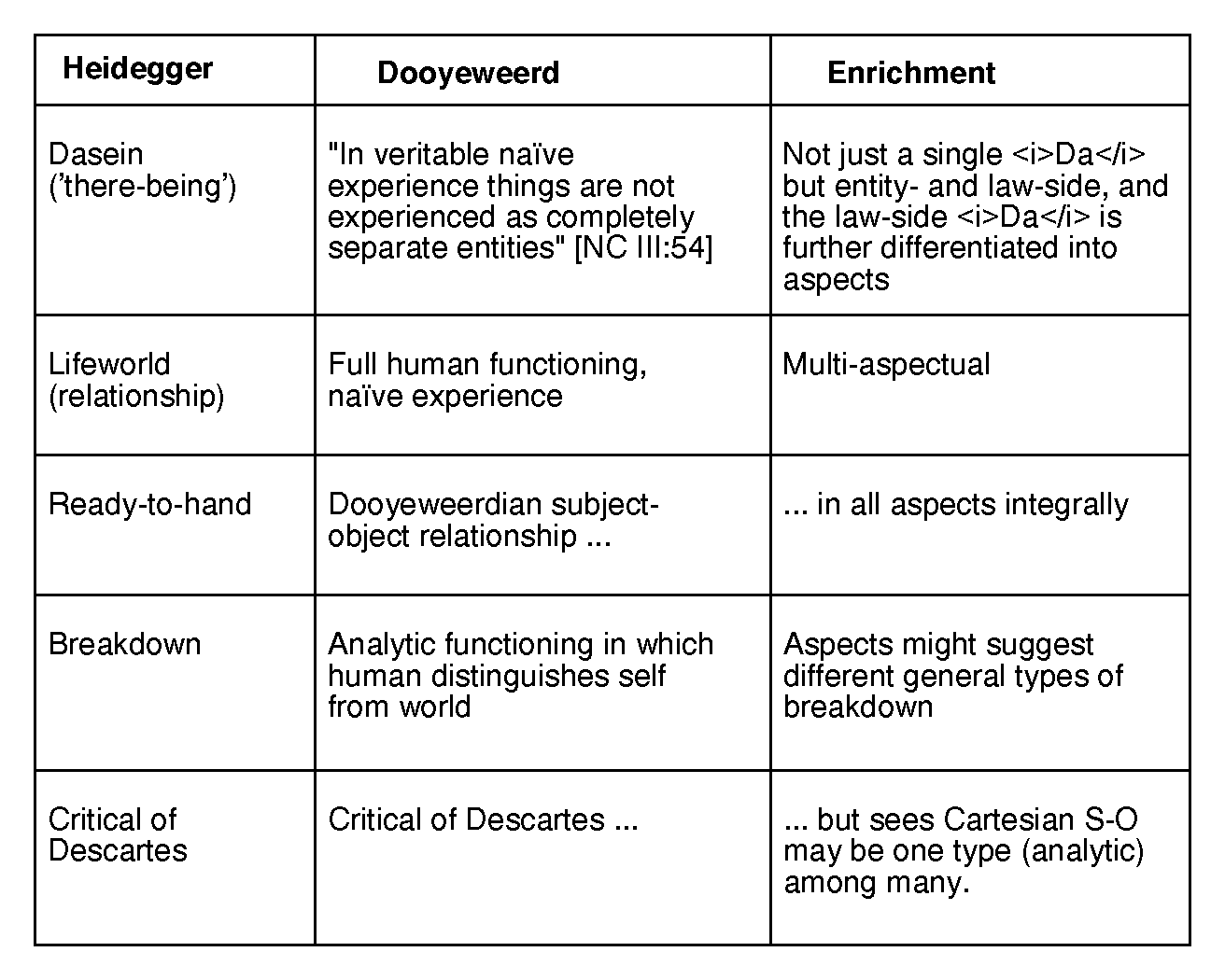

Now, let us look into each area. What is below is a summary, which omits much.
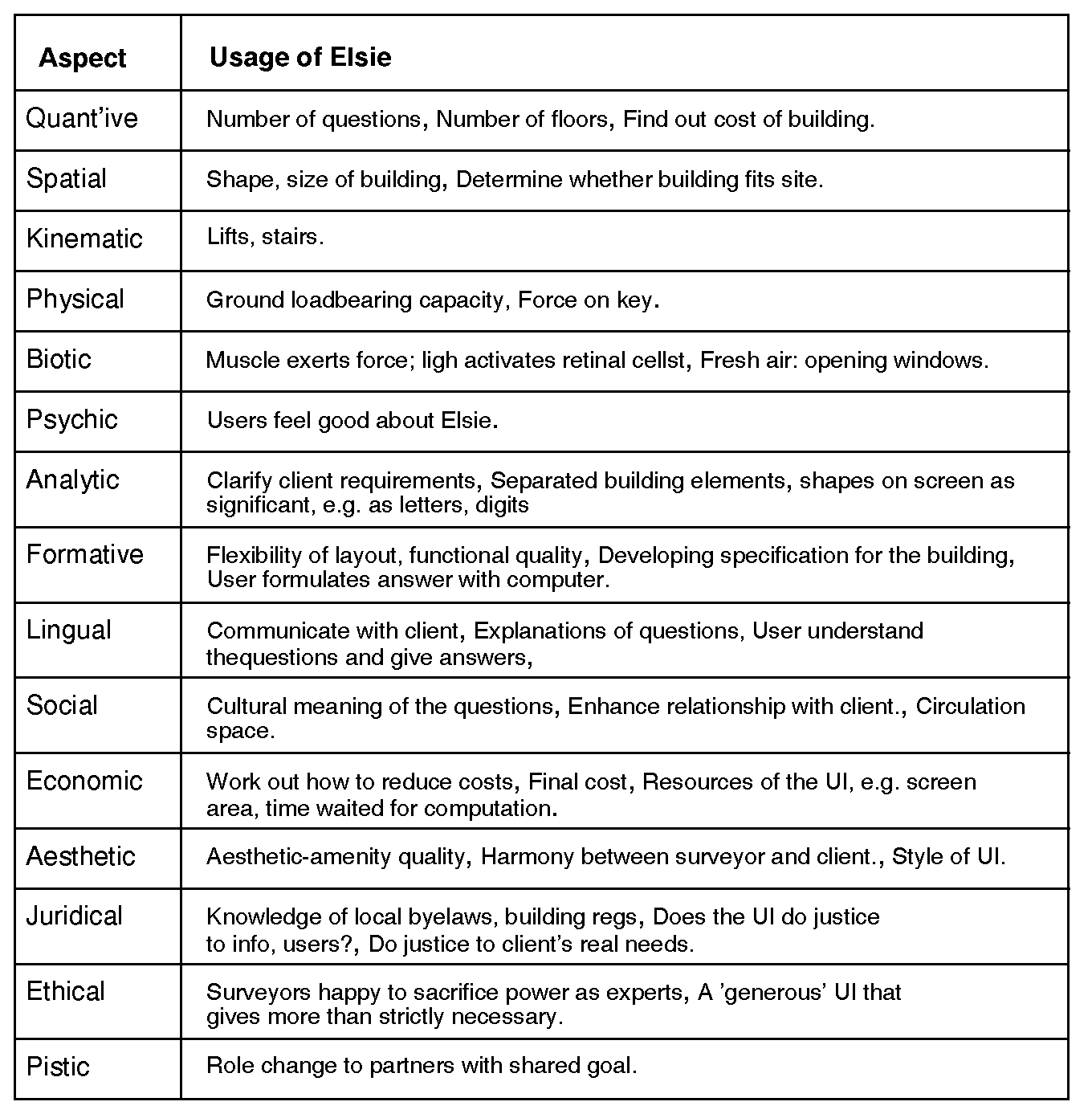
But that is still a bit 'mixed up'. It becomes clearer if we recognise that there are at least three multi-aspectual human activities in using an IS like Elsie, and in each, every aspect is important - HCI (human-computer interaction), ERC (engaging with represented content), HLC (human living with computers):
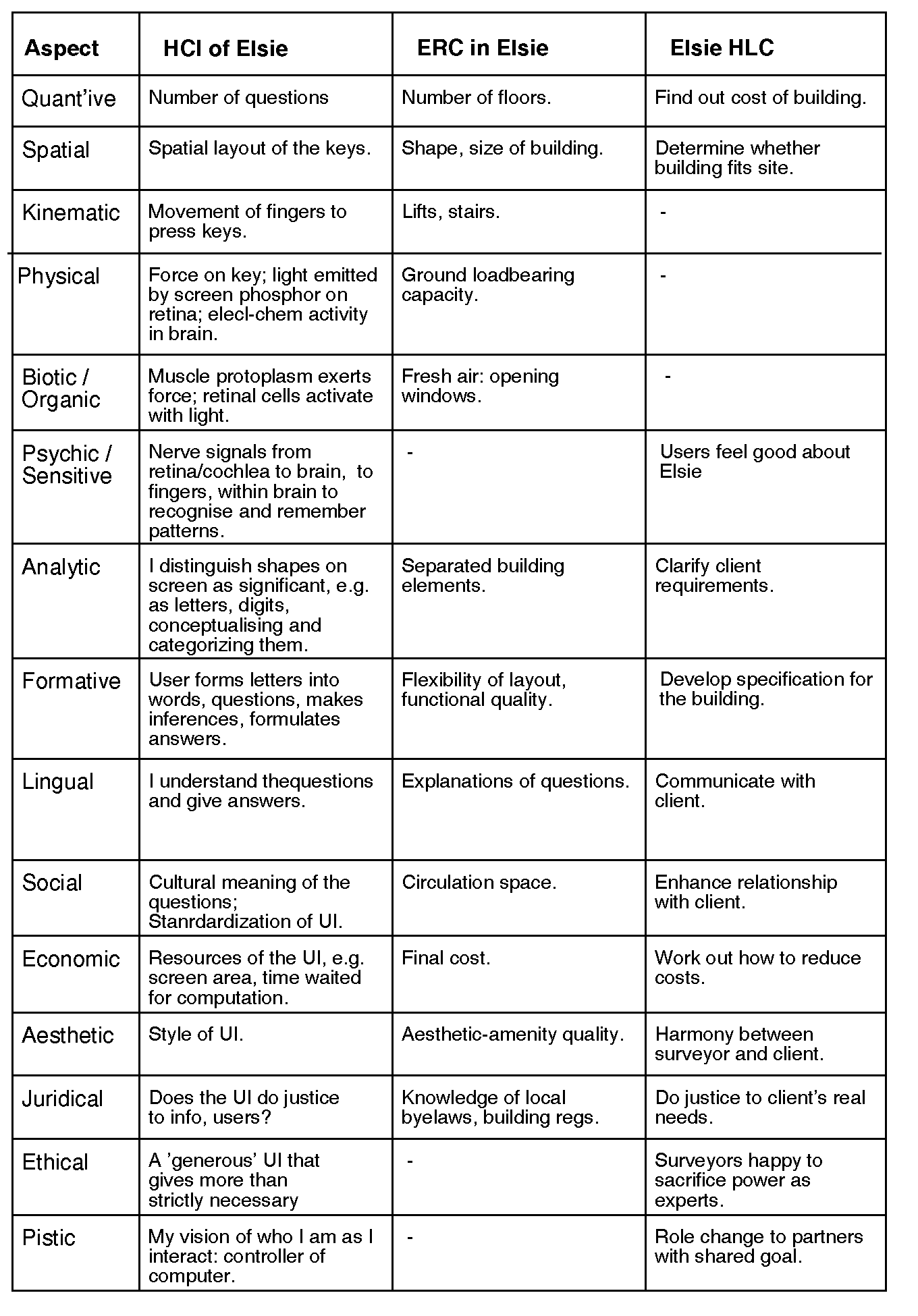
What is this 'engaging with represented content'? It is particularly important when engaging with a 'virtual world', such as when playing the computer game, ZAngband:
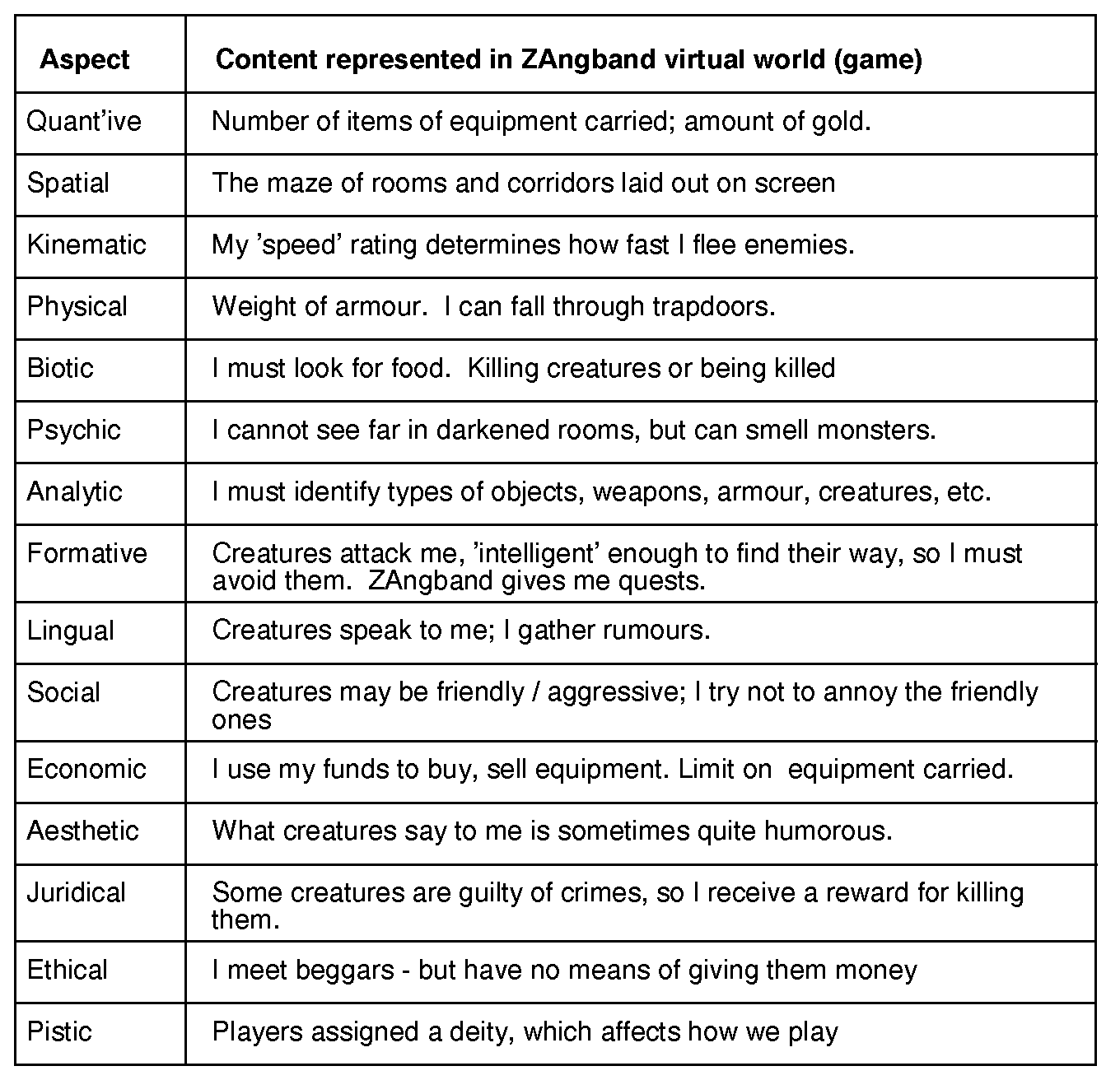
When I interact with my computer, I do so at every level (in each aspect), and both I and my computer do things that may be described as meaningful in each - and those in the later aspects depend on those in the earlier:

But notice what the relationship is in each aspect. In the physical aspect it can be subjec-subject relation, since the computer can function as subject therein, whereas in all later aspects it can only be a subject-object relation (note: this Dooyeweerdian view of subject and object differs from the conventional one:
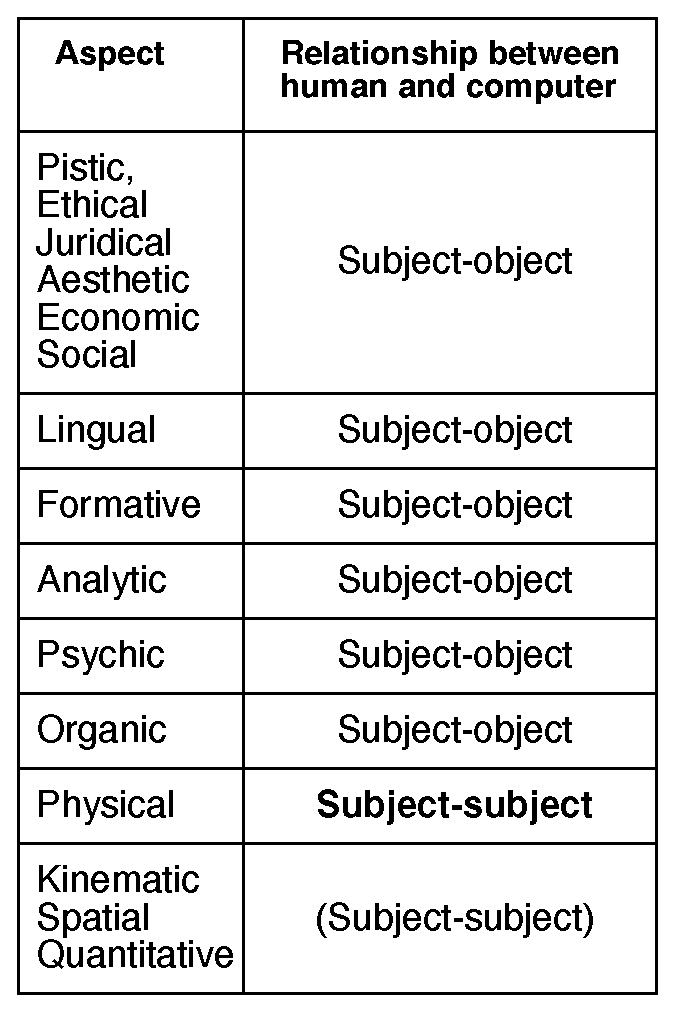
Human activity in using a computer has many repercussions, in all the aspects:
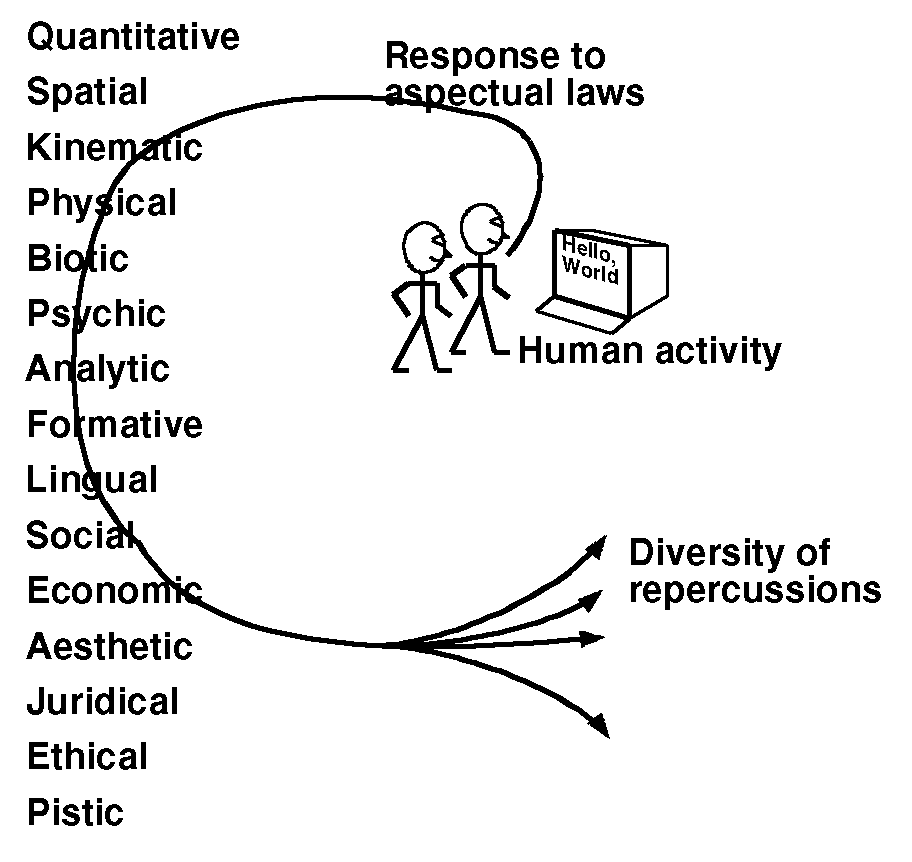
We can also understand the impact that use of computers has in terms of aspectual repercussions, many of which are social. For example, if I create a document or email that is poorly worded, then whoever reads it might get angry and might think I am being rude (think of other such aspectual repercussions):
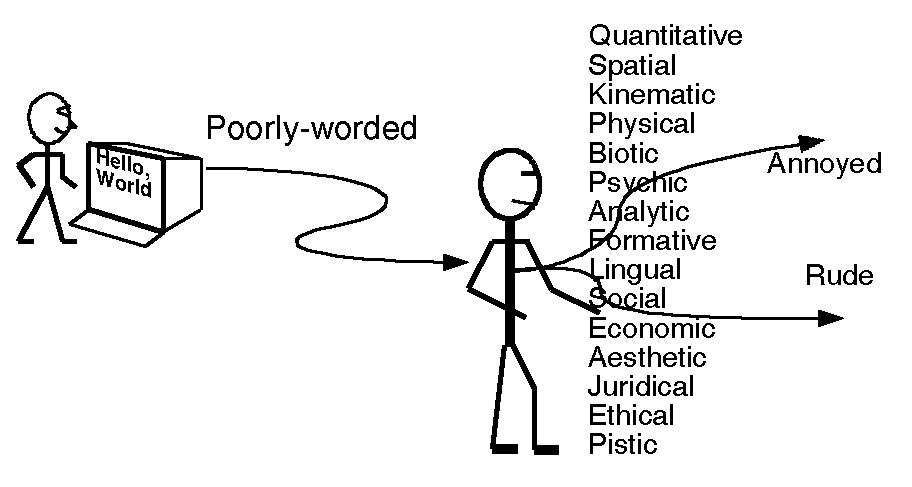
Such repercussions can be either positive or negative (or both) in each aspect. Here is a diagrammatic way of showing this - the 'aspect tree':
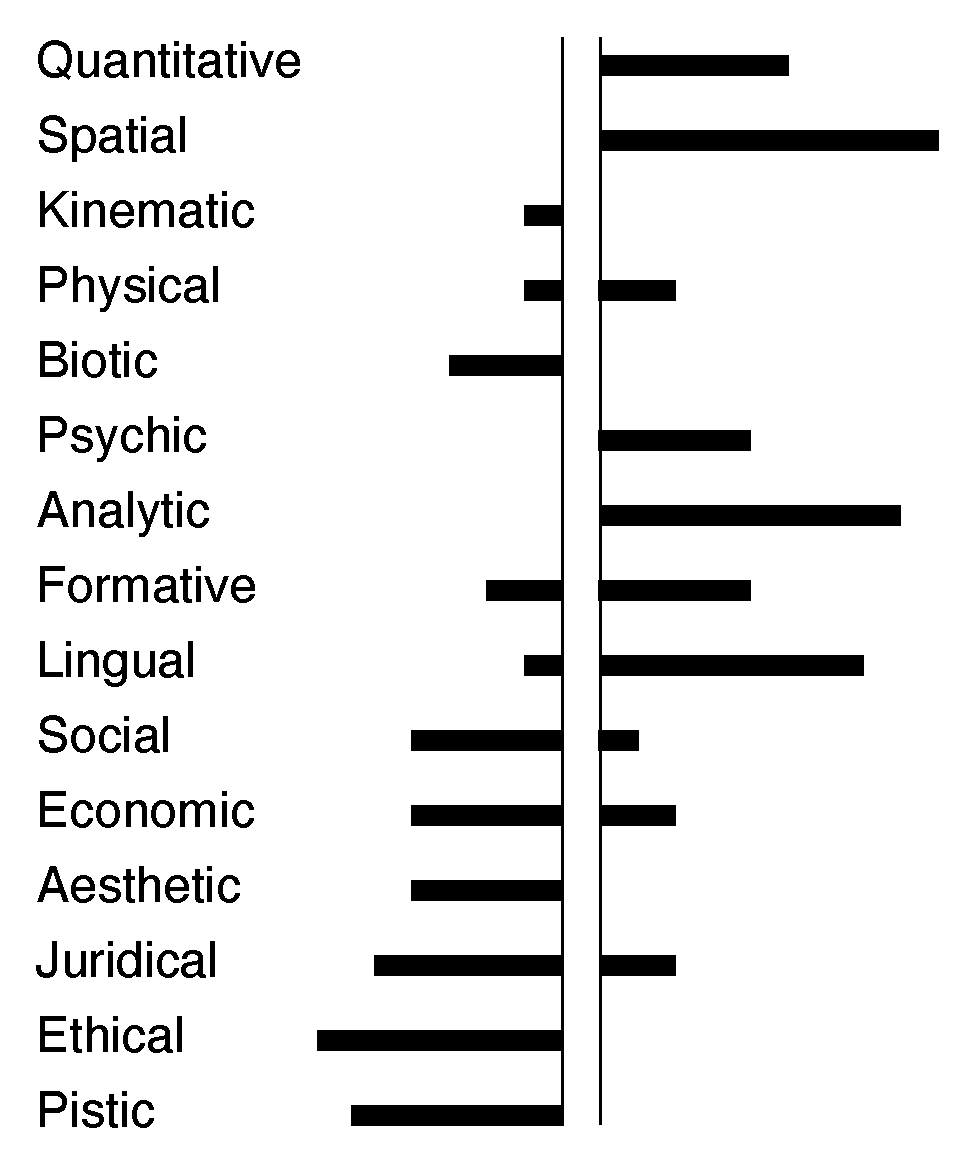
We can used an aspect tree to analyse the failure of a computer system. Take, for example, the Mitev's [2001] description of the SNCF Socrate system (where each number refers to an aspect):
"Technical malfunctions (8), political pressure (15), poor management (11), unions and user resistance (15) led to an inadequate (13) and to some extent chaotic (12) implementation. Staff training (9) was inadequate and did not prepare (13) salespeople to face tariff inconsistencies and ticketing problems. The user interface was designed using the airlines logic and was not user-friendly (6). The new ticket proved unacceptable (6) to customers. Public relations (9) failed to prepare the public to such a dramatic change (12). The inadequate database information (7) on timetable and routes of trains, inaccurate fare information (1), and unavailability (11) of ticket exchange capabilities caused major problems for the SNCF sales force and customers alike. Impossible reservations (8) on some trains, inappropriate prices (13) and wrong train connections (3) led to large (1) queues (2) of irate (6) customers in all (1) major stations. Booked (13) tickets were for non-existent trains (11) whilst other trains ran empty (11), railway unions went on strike (11), and passengers' associations sued SNCF (13)." [Mitev's referencing removed]
Then, if we count the number of times each aspect is mentioned, either as aspectual functioning or aspectual repercussion, we obtain two aspect trees:
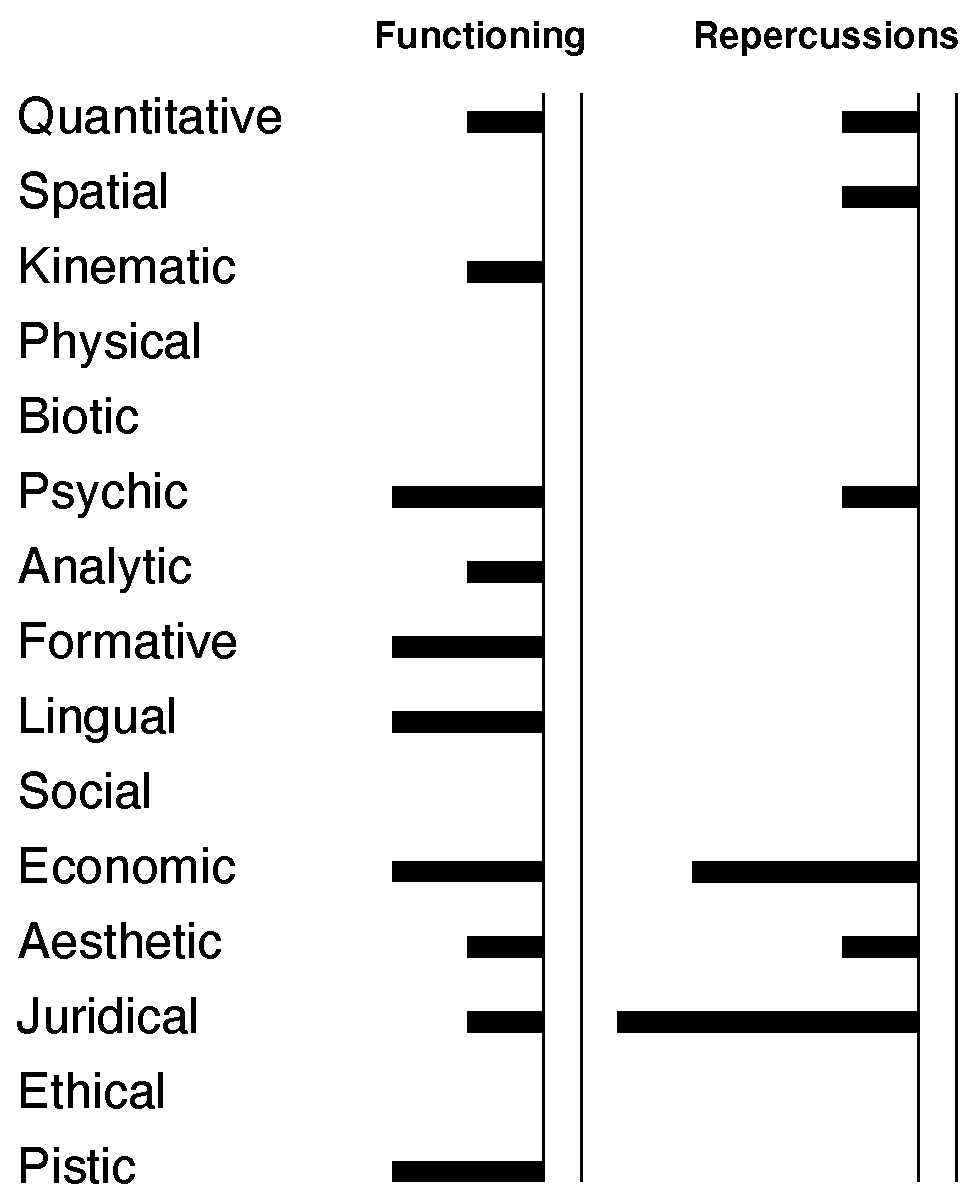
Latour's Actor-Network Theory is often used in an attempt to get a grasp of complex social situations involving computer systems, as a network of 'actants'. But Dooyeweerd can enrich this by adding the dimension of aspects: each link involves different aspects, and each actant is a multi-aspectual being:
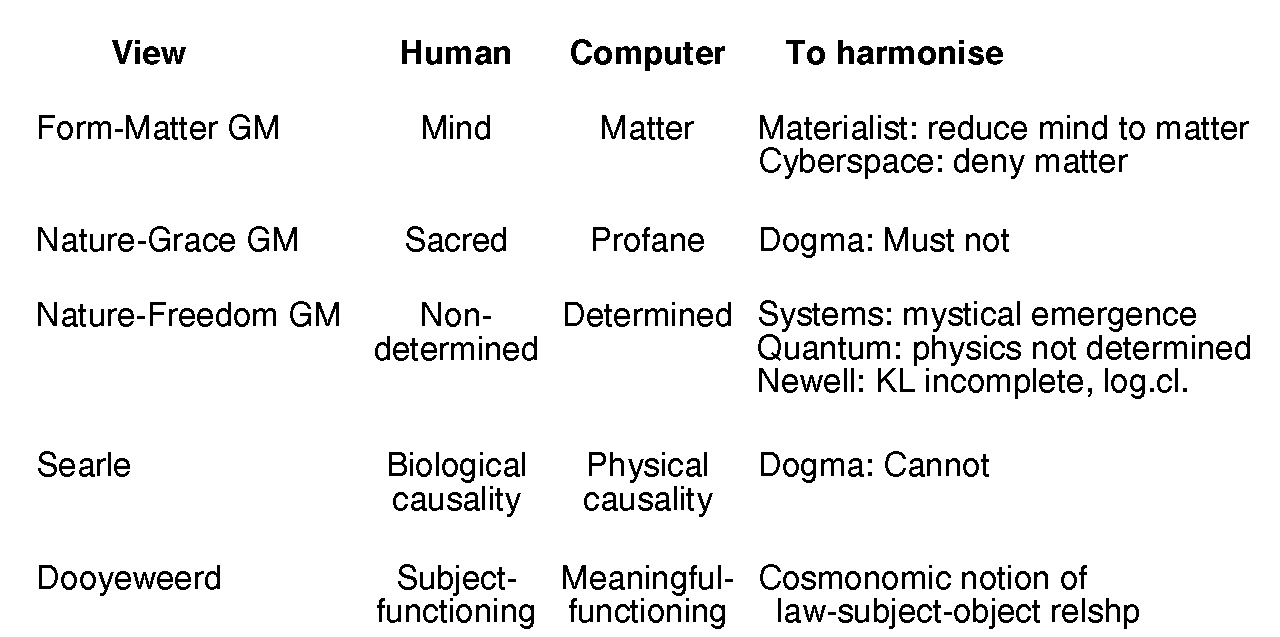
One view we may derive from Dooyeweerd is to distinguish between 'subject-functioning' (spheres of meaning in which the computer functions as subject, namely up to including the physical) and meaningful-functioning (spheres in which it functions as either object or subject, by virtue of human subject-functioning in those spheres, which is: all of them). (See above about S-O and S-S.) With this, we can answer both Yes and No to whether a computer can understand, think, etc., in contrast to most other views, which can give only one answer about what a computer 'actually is' or can do:
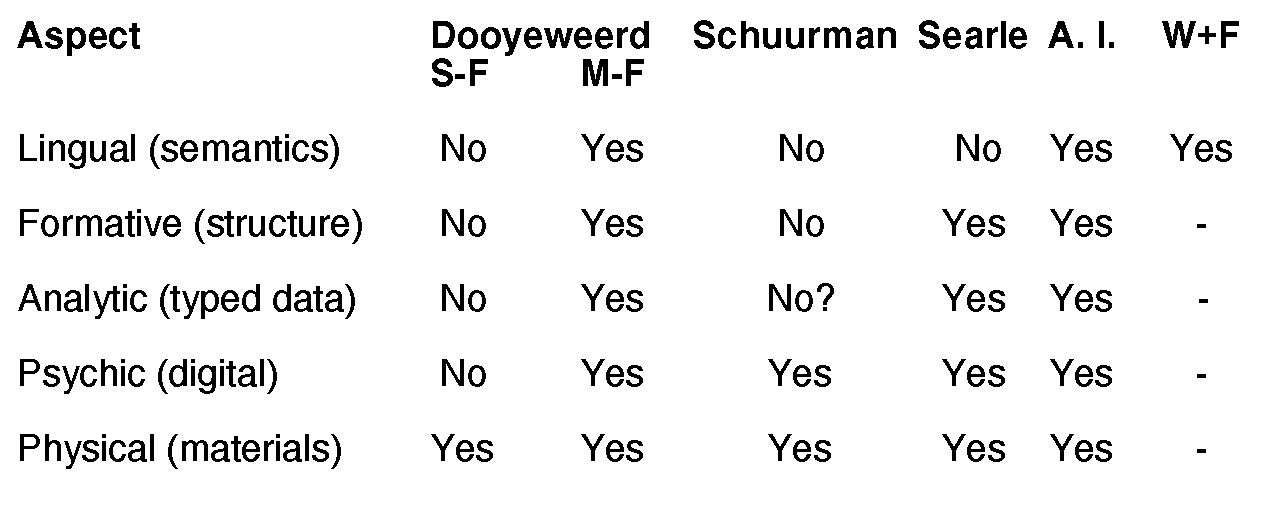
We can begin to obtain a useful understanding of the nature of computers if we focus on the meaningful-functioning (i.e. aspects in which the computer is meaningful as a computer):
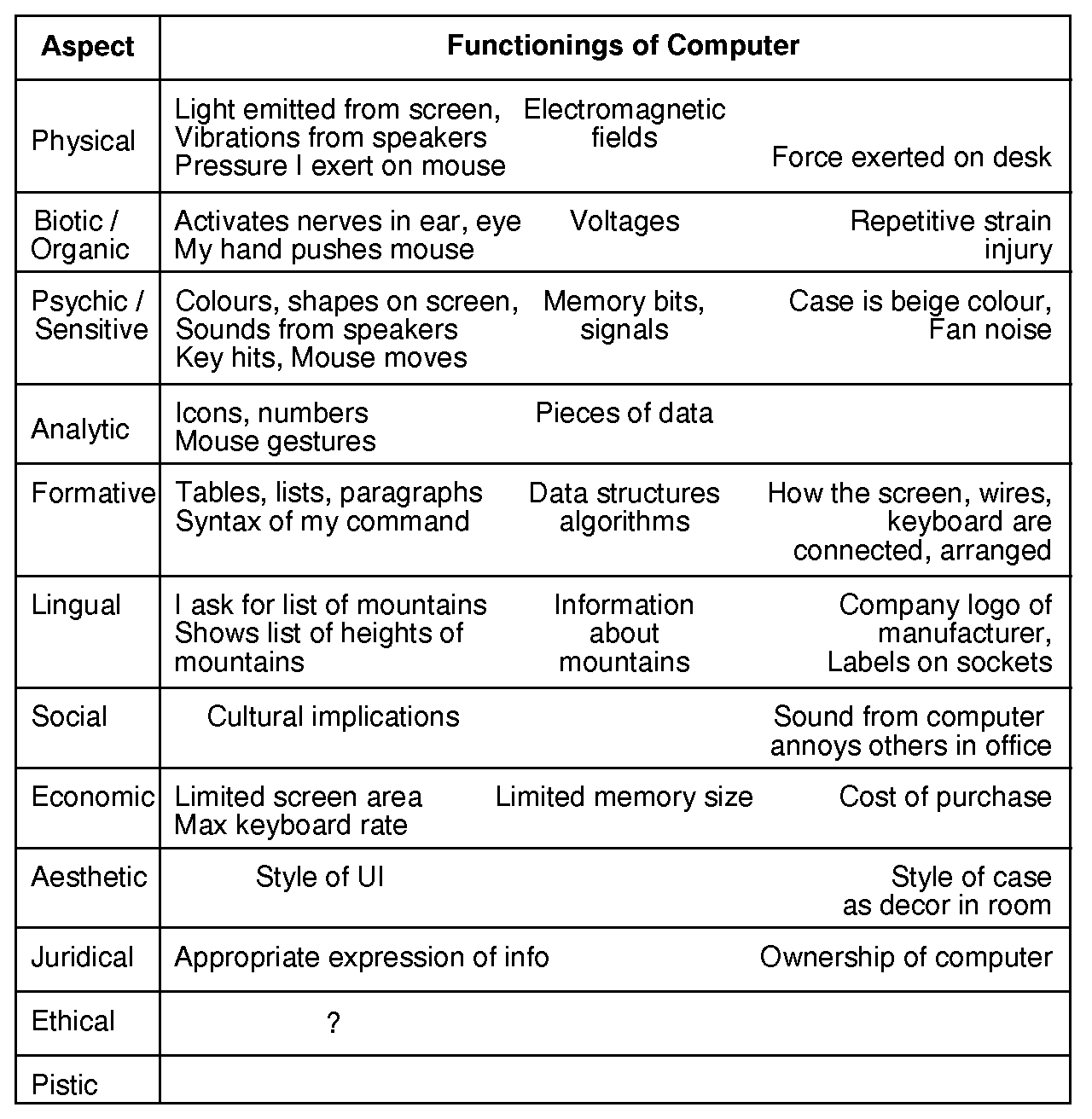
(Note the three columns. Right-hand column is superfluous to its functioning as a computer. Left-hand column is what we as users directly experience. Middle column is the hidden 'innards'. Dooyeweerd's discussion of how na´ve experience is broadened by scientific instruments to let us experience such things is useful.)
If we take only the middle and perhaps left-hand column - aspects of a computer as such - then we find aggregation (part-whole relations) within each level:
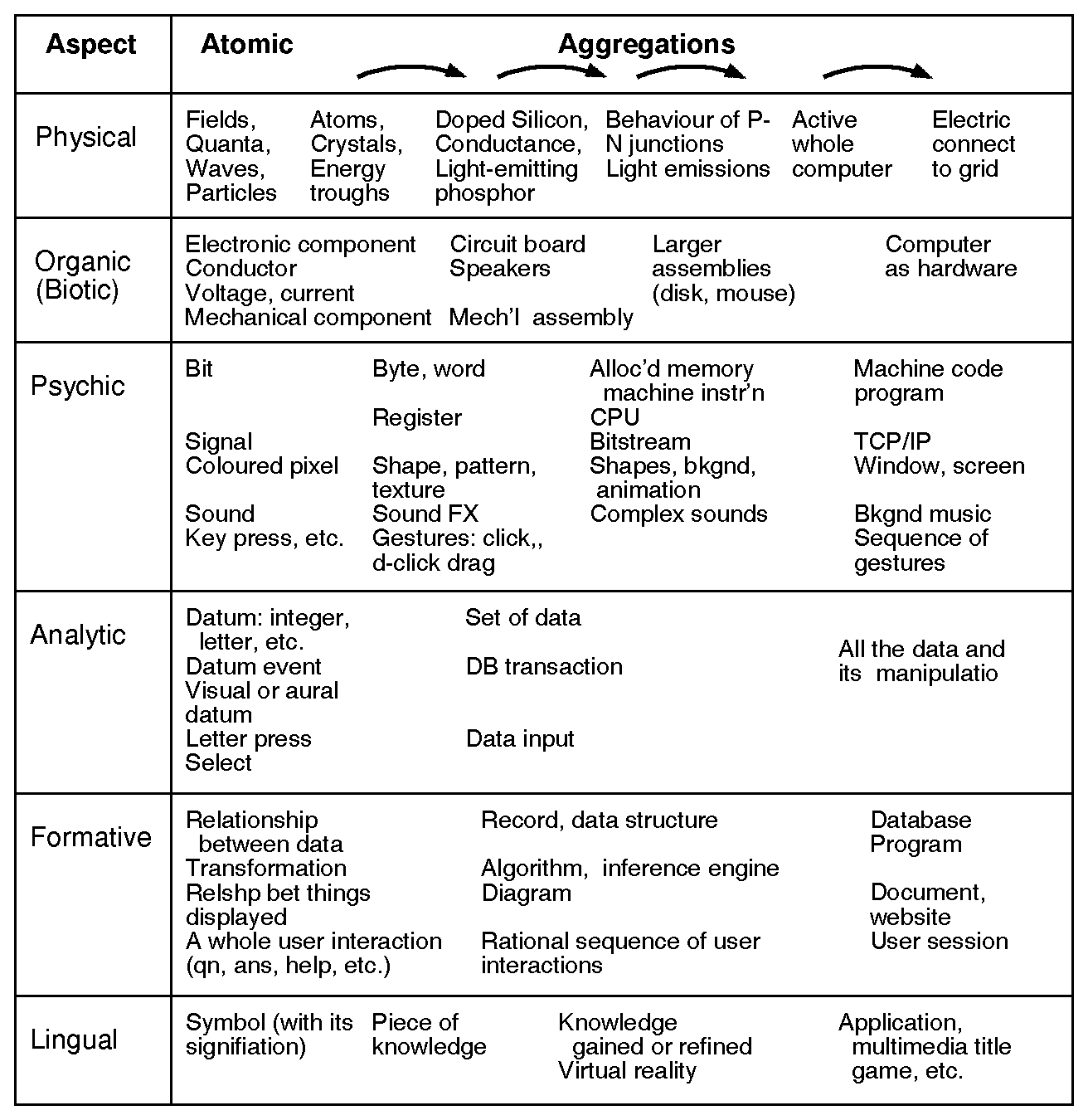
This suggests the computer is a multi-levelled being. It is interesting that Allen Newell came up with a similar idea [Newell, 1982]. Newell's levels strongly parallel some of Dooyeweerd's aspects (and his notion of levels is remarkably like Dooyeweerd's notion of aspects, though there are some differences, the root of which may be traced to his immanence standpoint.):
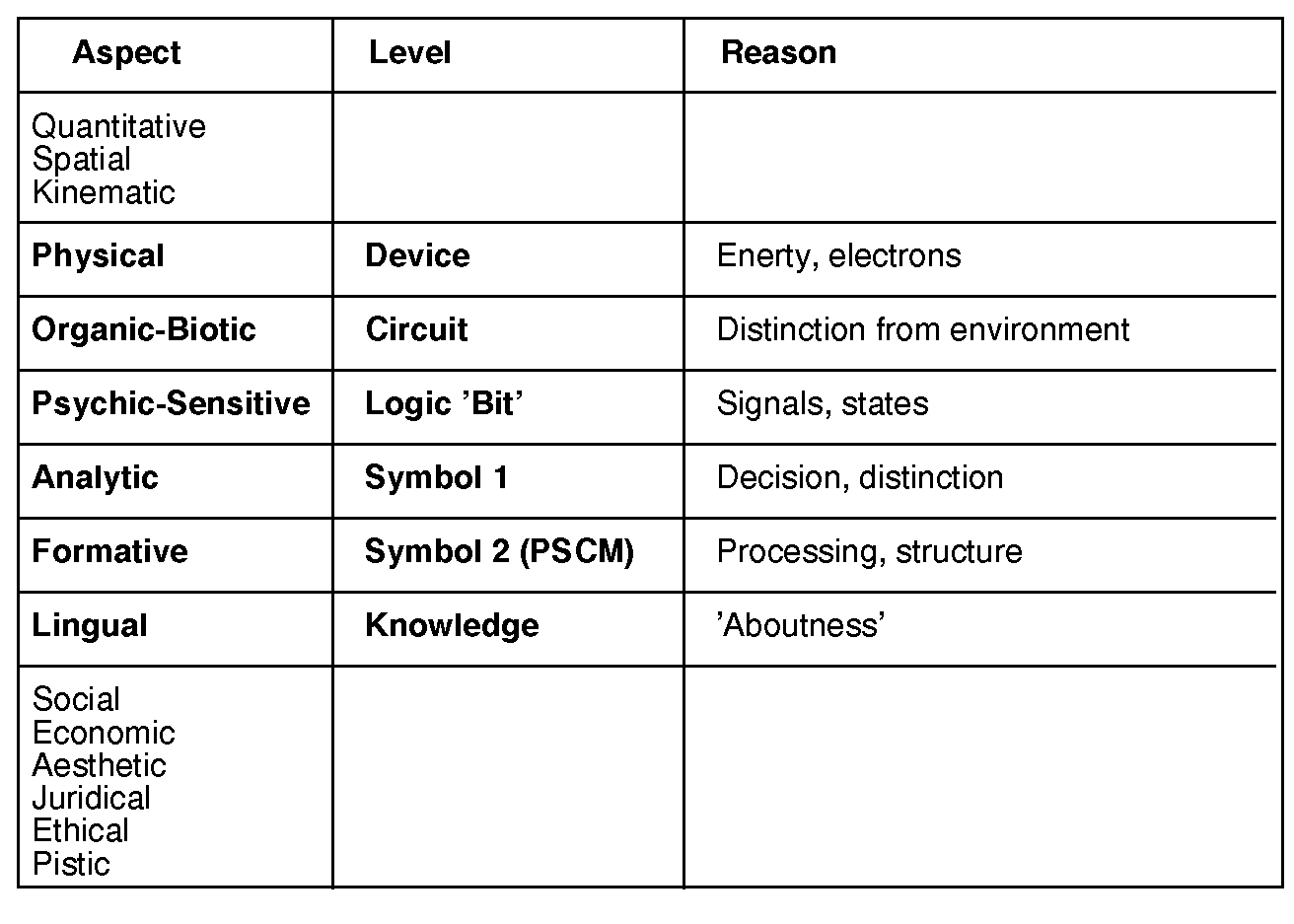
I discovered Newell's theory of levels long before I discovered Dooyeweerd, and liked it. I still use it in my teaching:
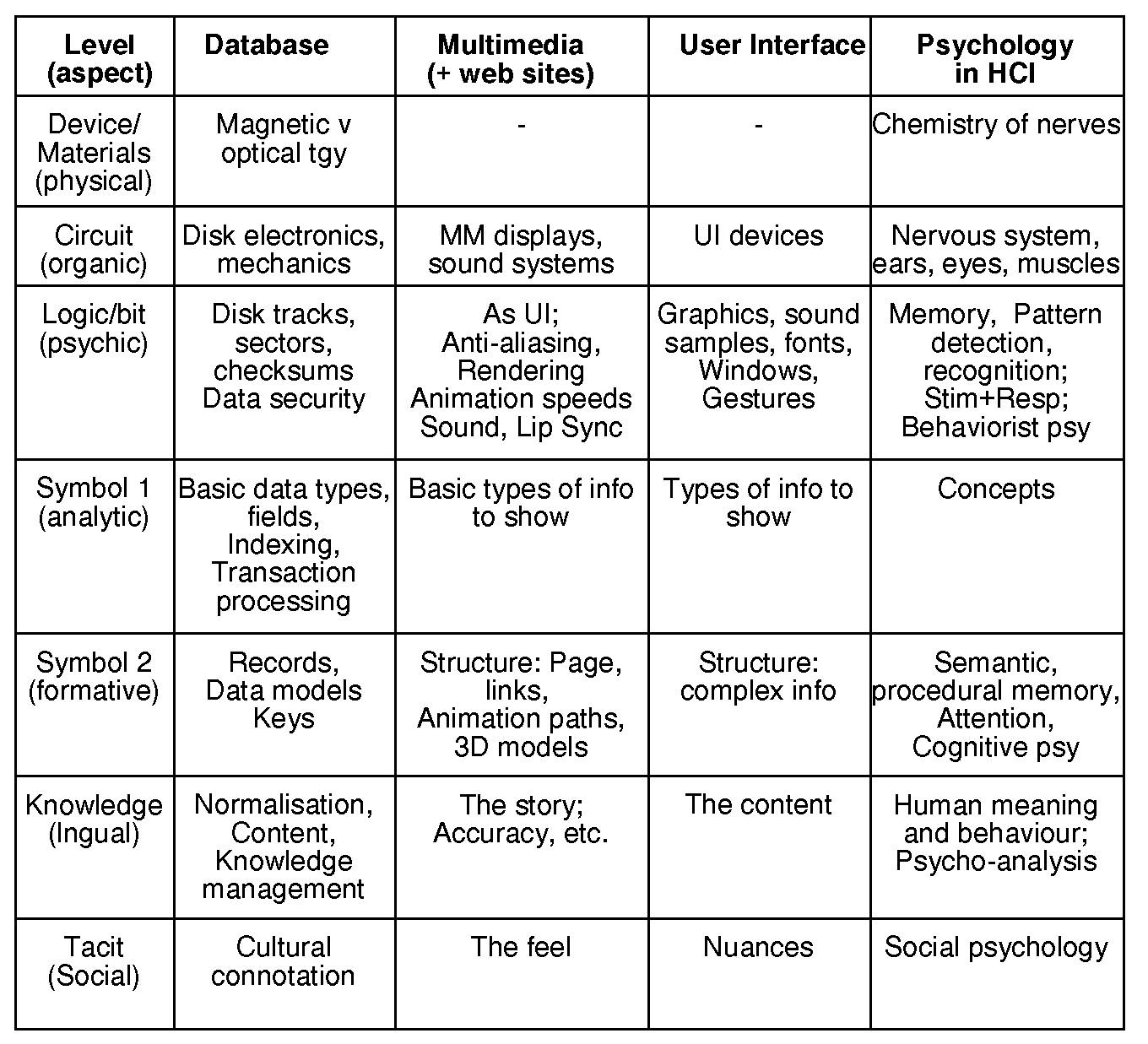
Maybe I will gradually move over to Dooyeweerd now?
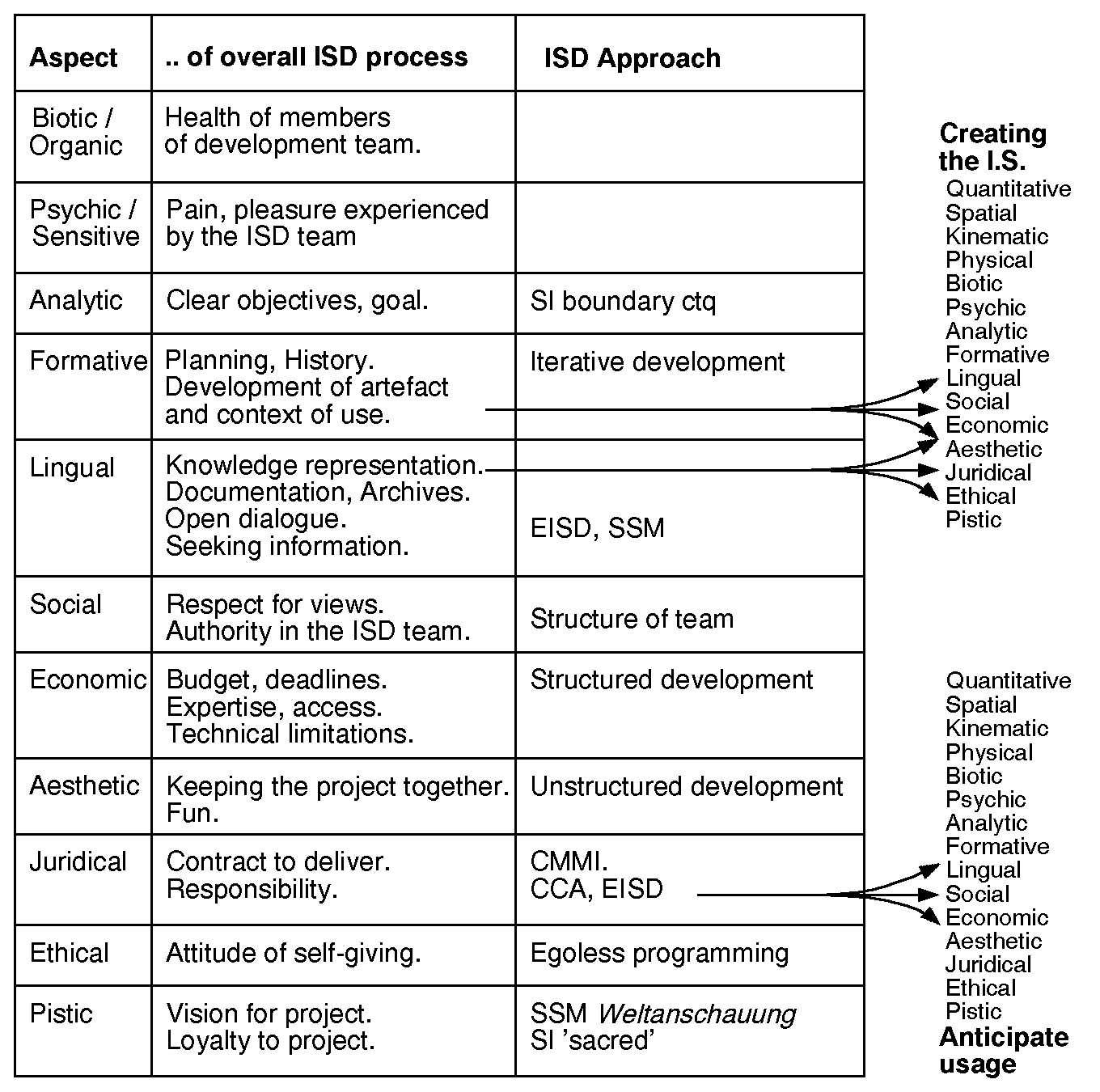
This is very much a social process (several people involved, such as a formal team of developers, various experts drawn in to provide knowledge about the domain of application, various users, other stakeholders, etc.) Dooyeweerd's theory of social institutions, and his differentiation between intra- and inter-communal and personal relations, helps us understand more clearly the dynamics of the ISD process and how we should treat or respect each type of participant:

One of the processes interwoven with this (by an enkaptic rather than part-whole relationship) is creating the information system, both building the technical artefacts (by 'programming', etc.) and also shaping its human and organisational context. This too is a multi-aspectual process:
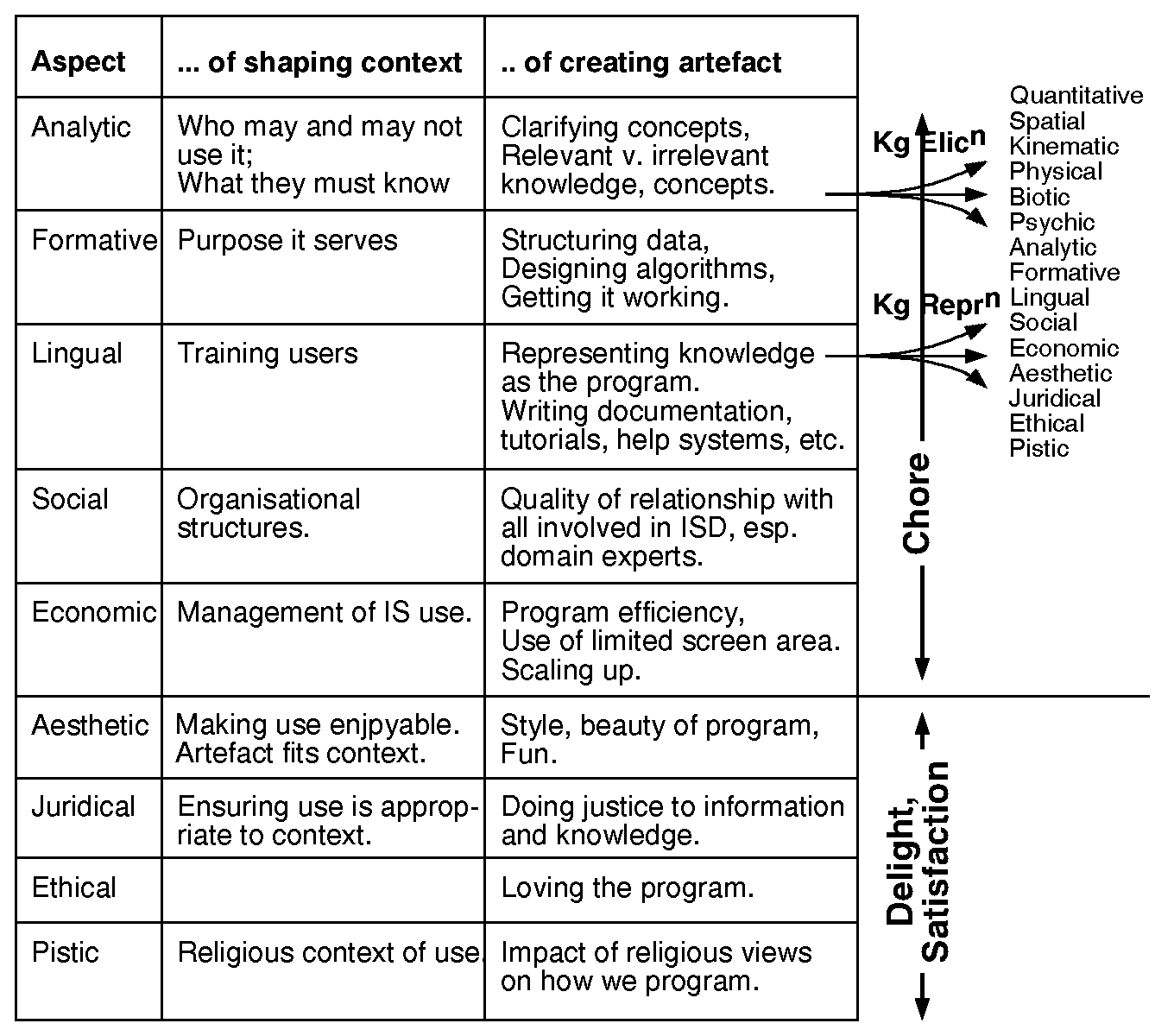
To create a computer system for human use means anticipating the eventual usage. Since that usage is multi-aspectual, then all aspects should be taken into account during ISD. Here is an example of aspects (Q for quantitative, etc.) of web page design. Specifically, the NCI web design guidelines have been analysed aspectually:
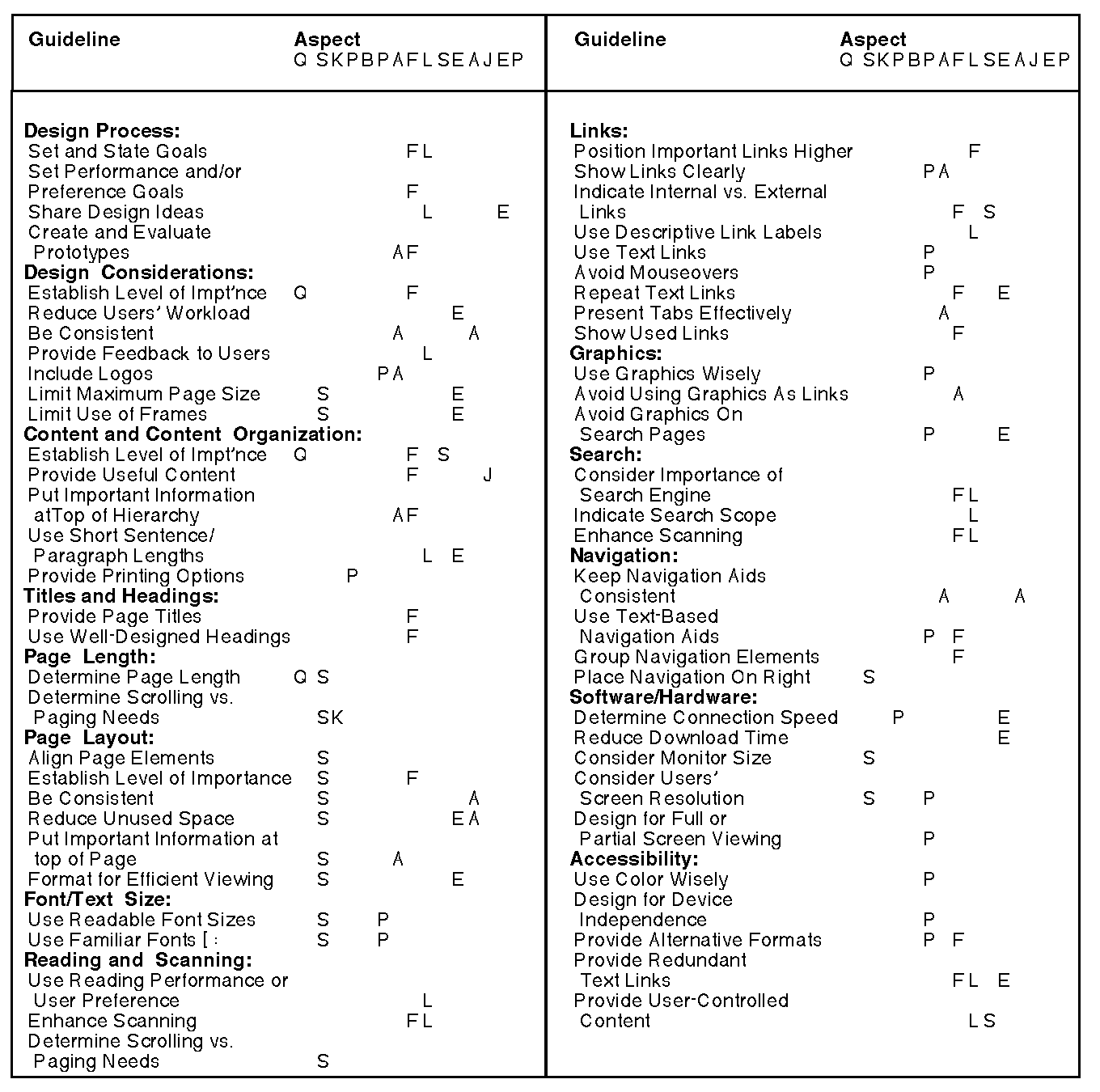
(Notice which ones are missing, and which ones are over-represented: does this indicate anything of the quality of these particular design guidelines?)
Knowledge elicitation (finding out what meaning is important in the domain of application, so it can be encapsulated or represented in the computer or its context of use) is yet another of the interwoven processes. The main norm of knowledge elicitation is to do justice to the domain meaning.
This means we need a method by which to ensure no relevant domain meaning has been overlooked. This is what Mike Winfield's 'Multi-Aspectual Knowledge Elicitation' technique, MAKE can achieve. This is not a checklist approach, as used for design above, but is a more sophisticated interview process, which generates 'aspect maps' of concepts relevant to a domain. Here is a tiny example aspect map:
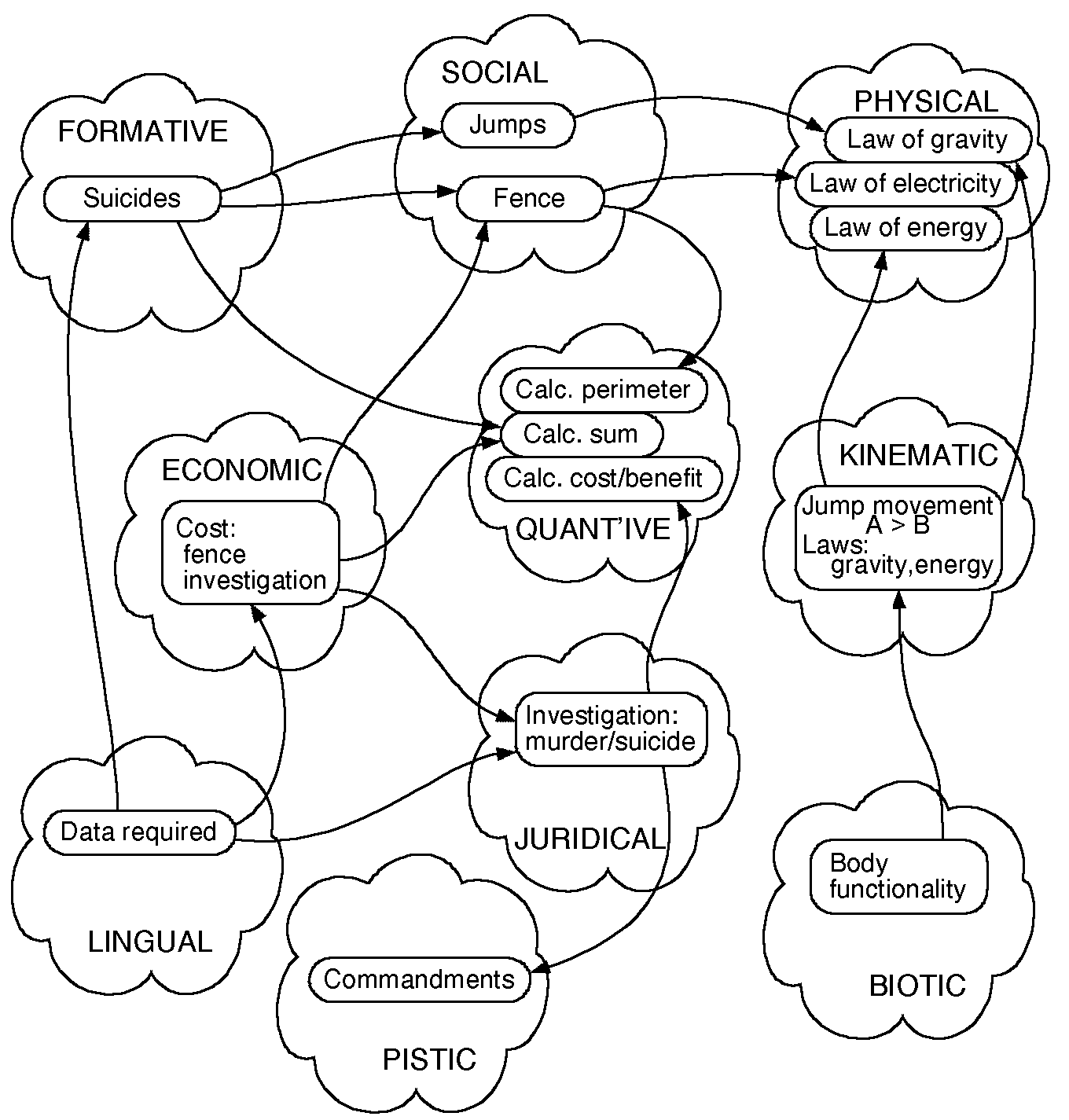
Finally, this approach is very different from most ISD approaches - hard systems thinking (HST), soft systems thinking (SST) or critical systems thinking (CST). Why is this? One answer, suggested by Eriksson [2006], is that each is dominated or driven by a ground-motive or one pole thereof:

But when the idea was taken over to software, it became rather impoverished by comparison:
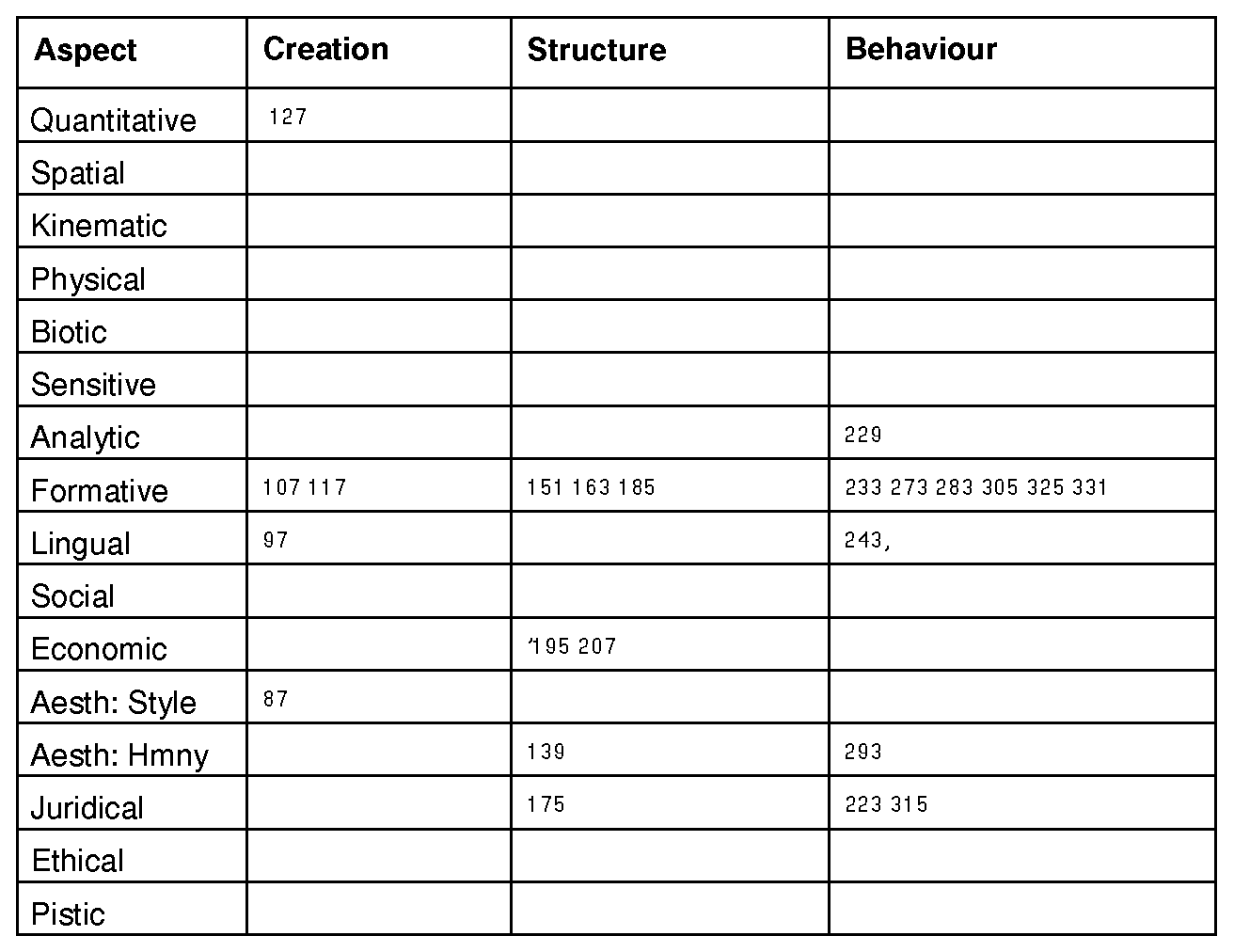
What we want is to provide a comprehensive set of building blocks (or 'design patterns') that guides the IS develop in every aspect. Dooyeweerd can help us.
Because of the importance of representation, this process, of creating the IS, is qualified more by the lingual than the formative aspect. The process of representation involves a number of aspects as follows:
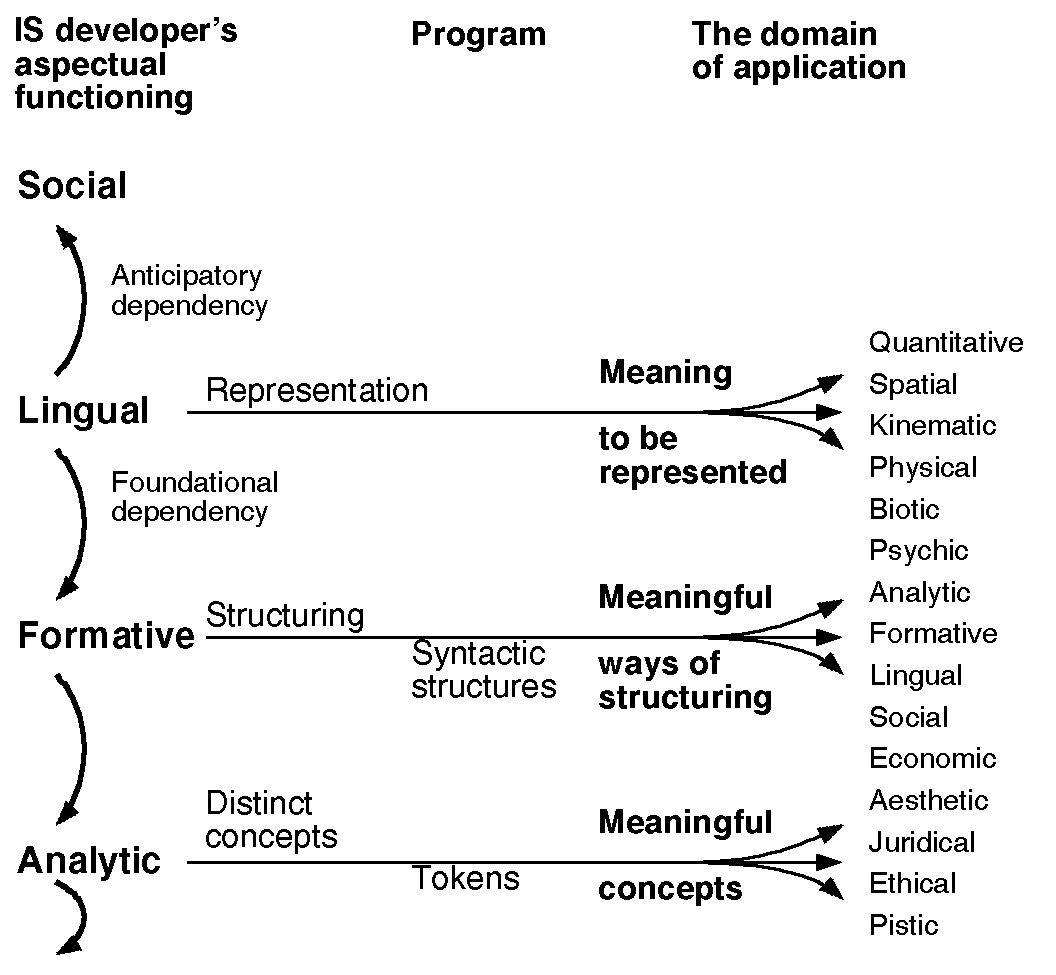
These building blocks themselves involve a number of aspects, in dependency relations:
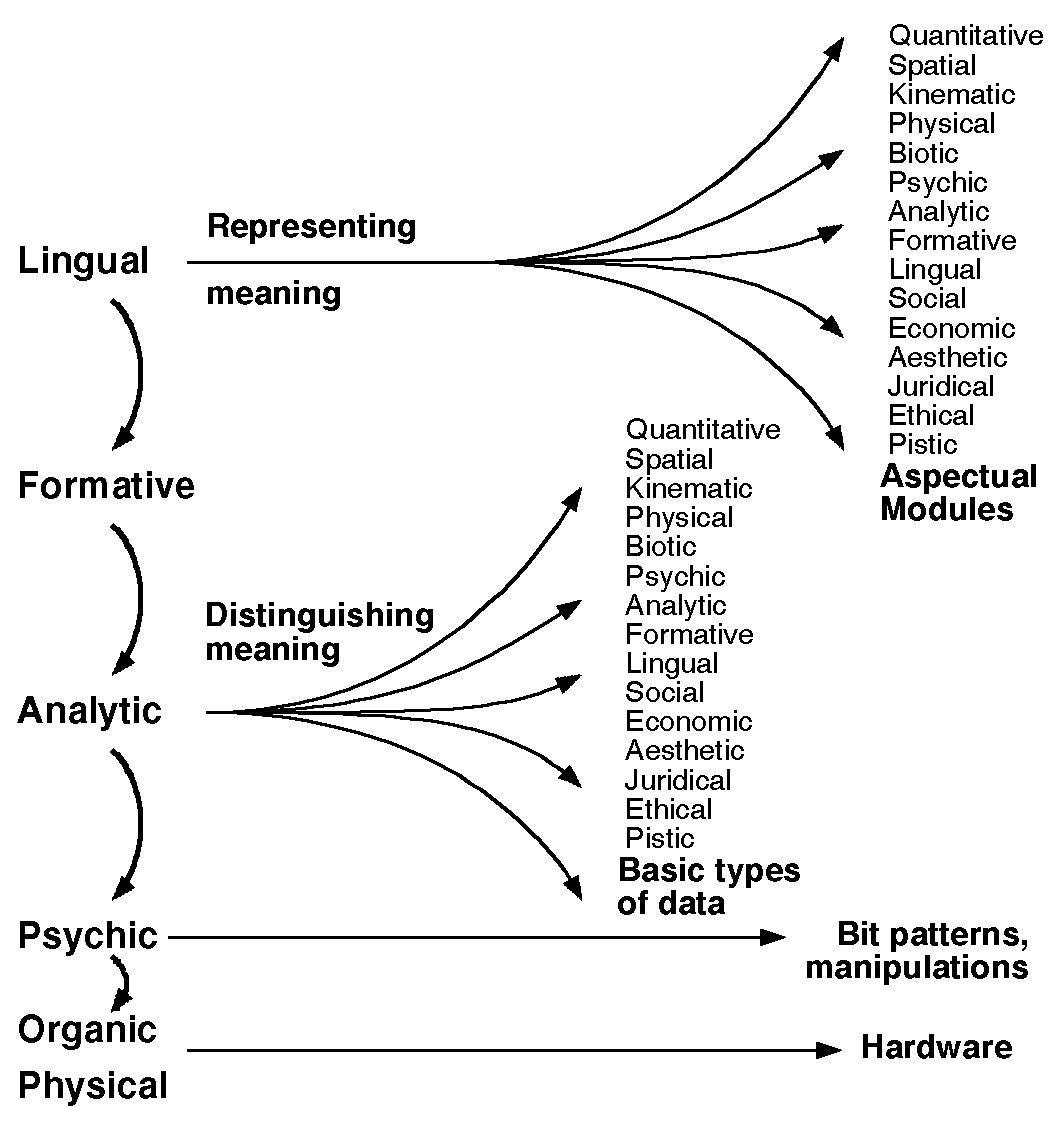
Above I have portrayed the psychic aspect as the sphere in which the 'bits' and signals of computer memory are meaningful, and the analytic aspect as the sphere in which basic data types are meaningful. If this is so, then we are likely to find special mappings from bit-patterns to types of data ('codings') for each aspect:
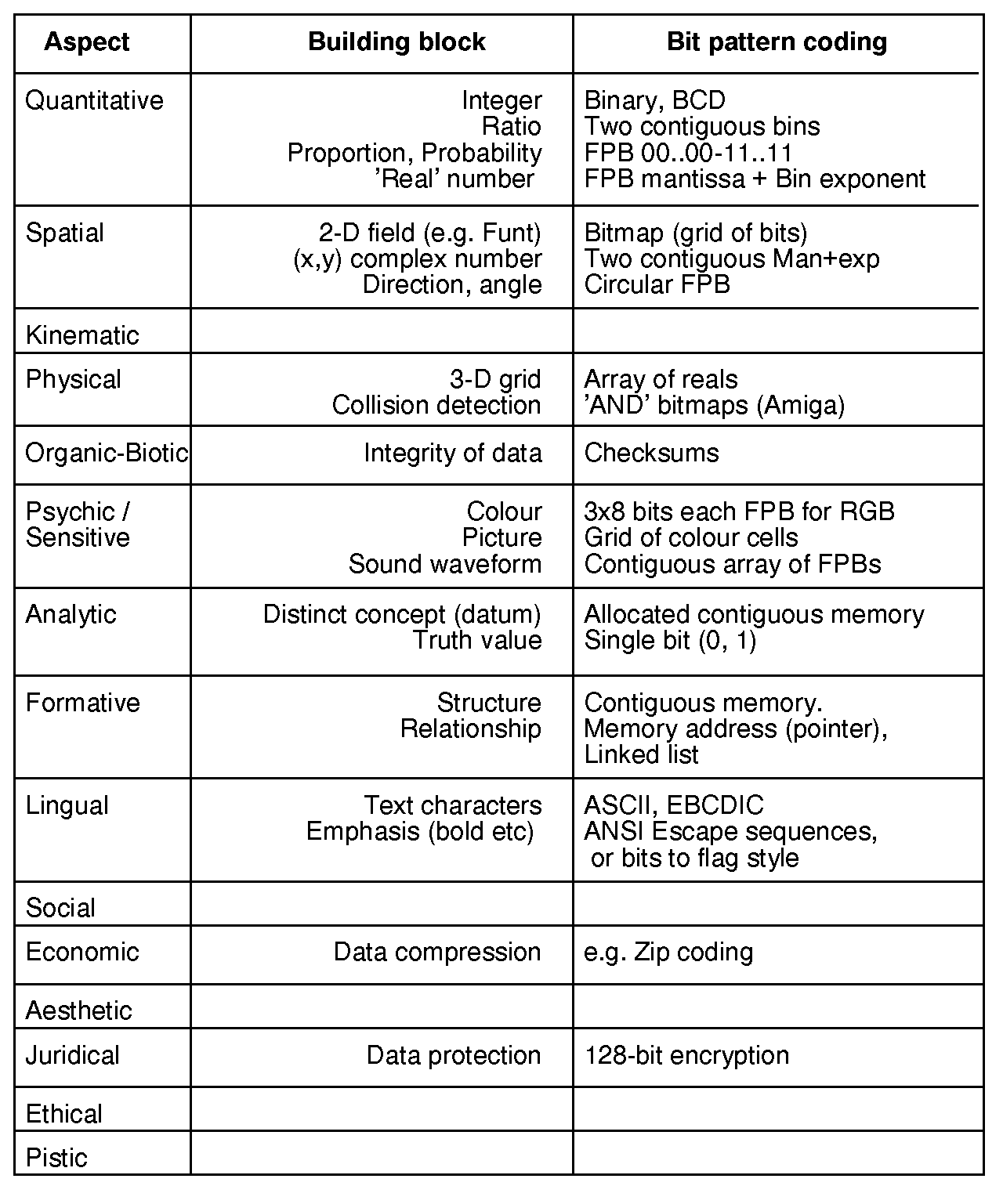
We may see these building blocks from the analytic aspect upwards as qualified by different aspects. Just as in the construction industry, some buildings are built of large pre-fabricated units, so many of today's software applications make use of what are sold as complete software packages. These might be seen as 'big building blocks', and they too are qualified by various aspects:
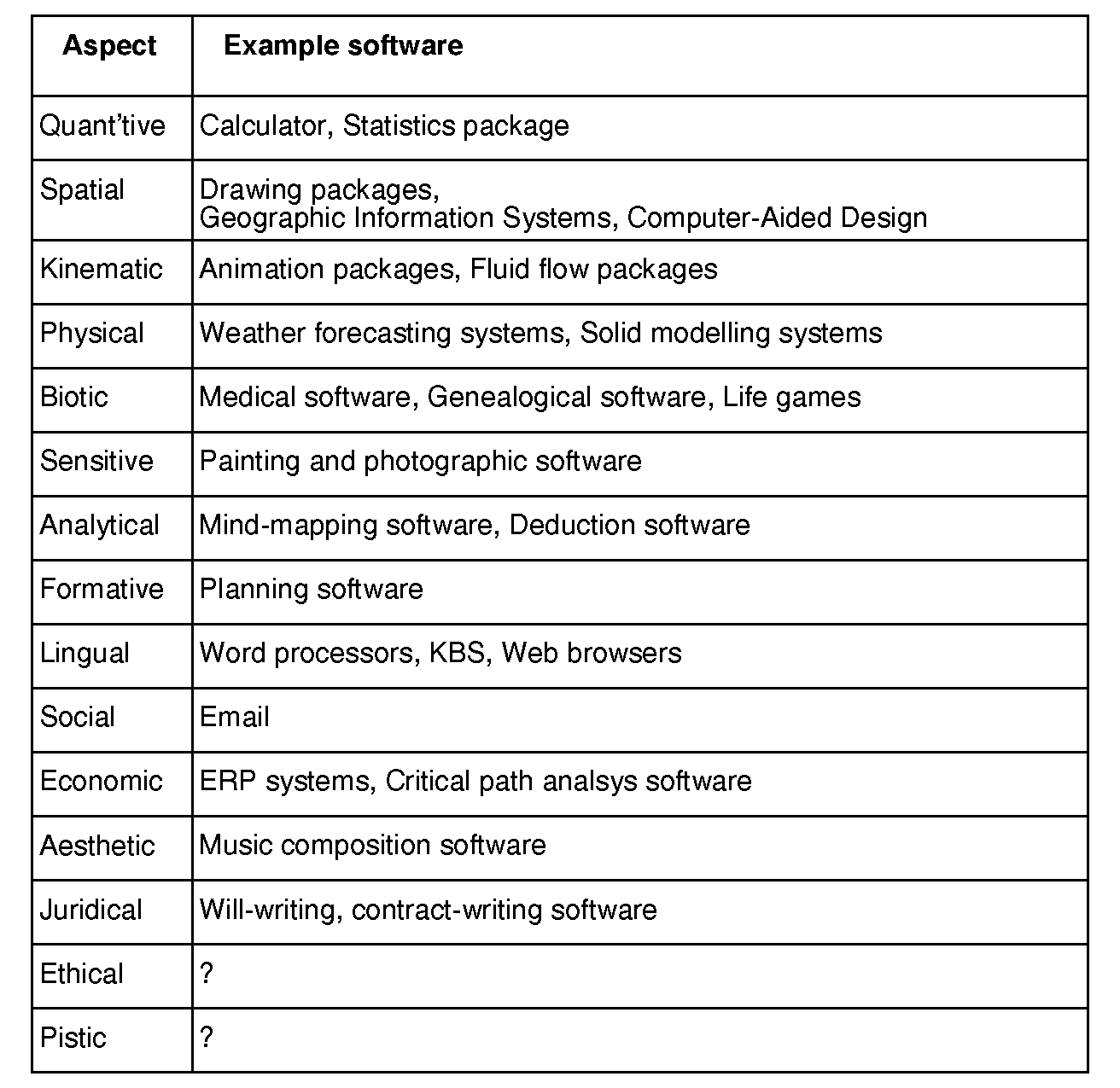
But most of these are unsuitable for the IS developer. What they need is smaller and more useful IT building blocks which make available the basic facilities needed for representing meaning in any aspect. Unfortunately, extant knowledge representation approaches cover only a limited range of aspects
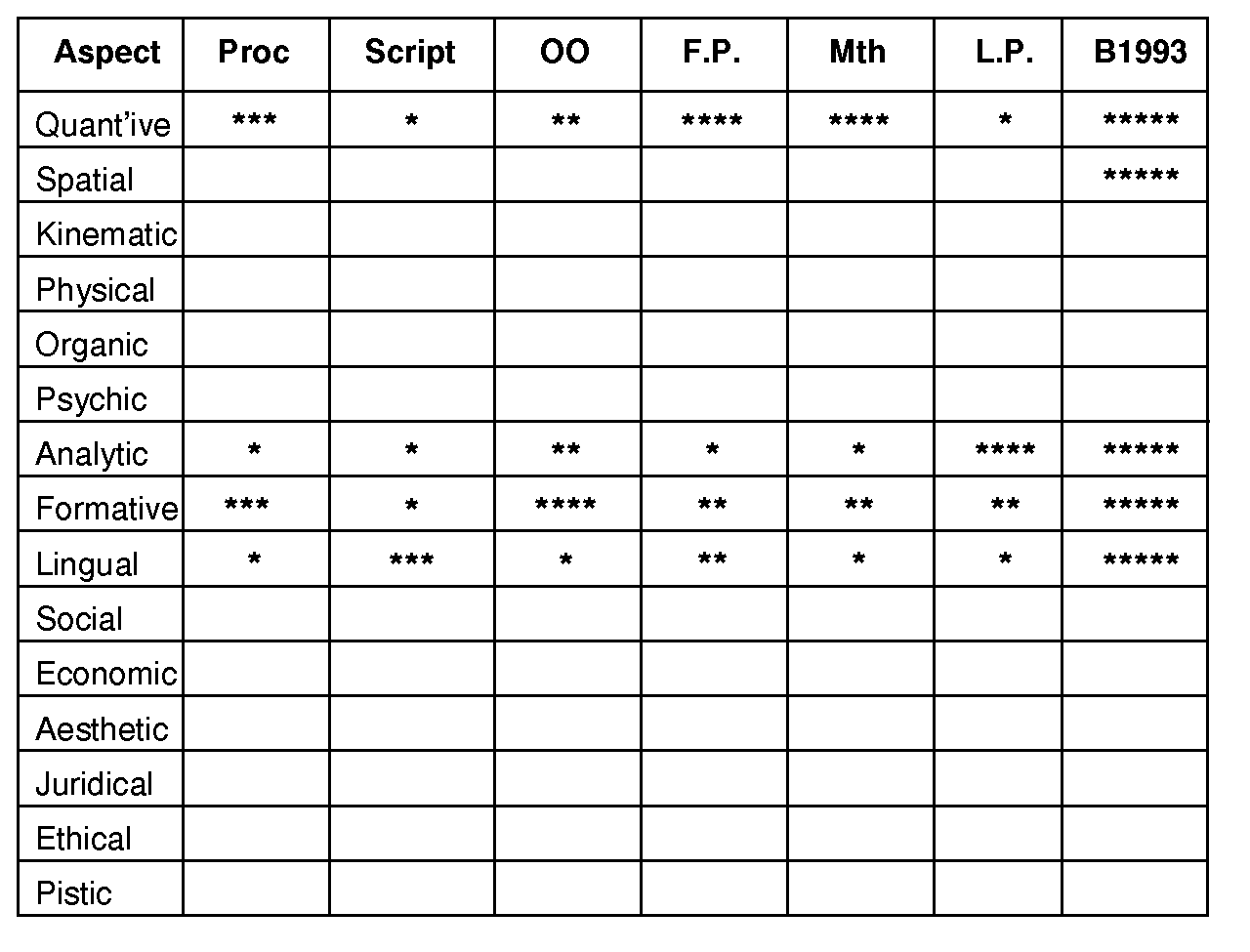
The result is that the ISD developer must take upon themselves the responsibility for representing the meaning of other aspects. For example, how would you represent a complex shape like (a) below in the computer, as follows, together with one of the basic operations on such shapes: expansion (b) below?
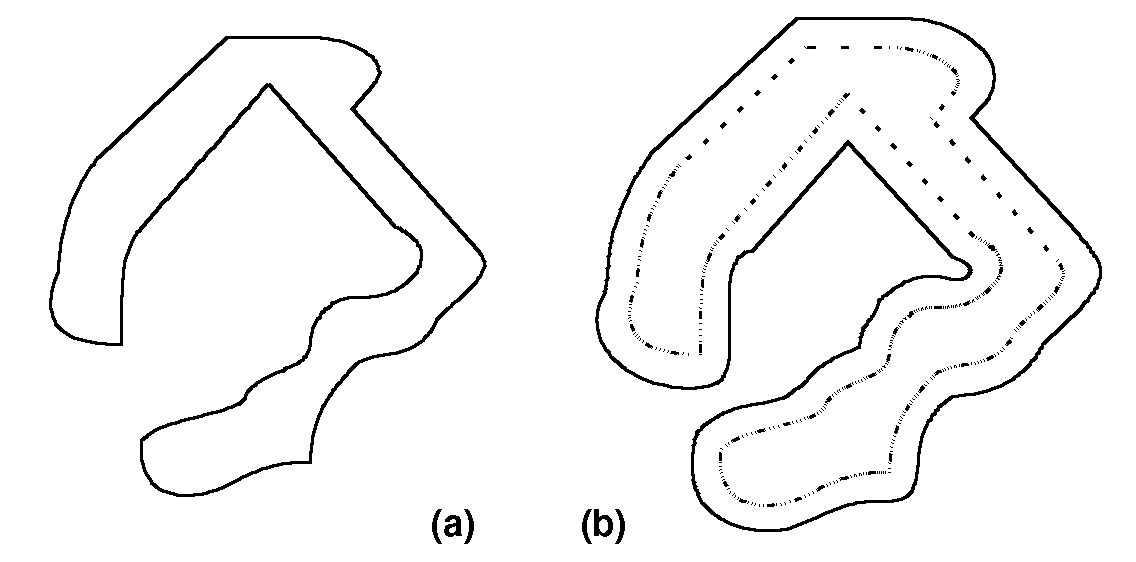
One common answer is to implement the shape (a) as a list of (x,y) coordinate pairs, and operations like expansion (b) using complex trigonometry. (Does any reader know the proper equations?) IS developers should not have to carry that burden. But it gets worse: A simple list of (x,y) pairs will not do, because expand further and we end up with a shape with a hole, which requires at least two such lists:
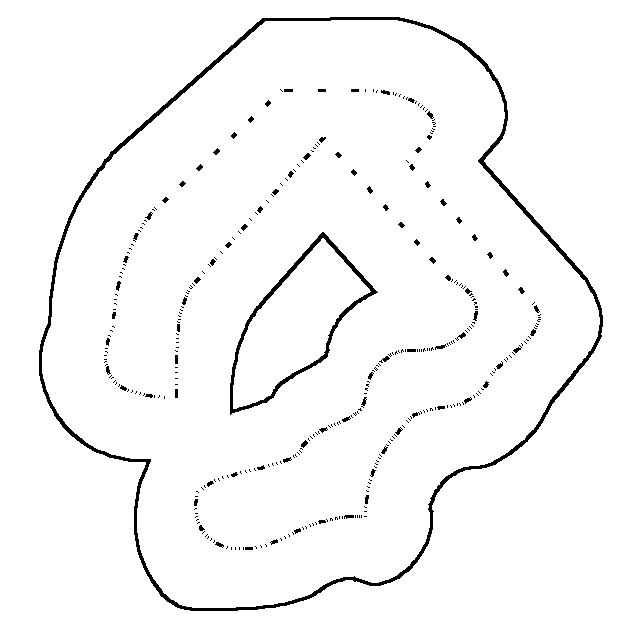
Such complexities are often only discovered a long time after the basic building blocks have been designed and set in concrete! The moral of this is that the basic building blocks for each and every aspect should be made available. The following is a suggestion for each and every aspect, based on what we call the philosophical roles of aspects:
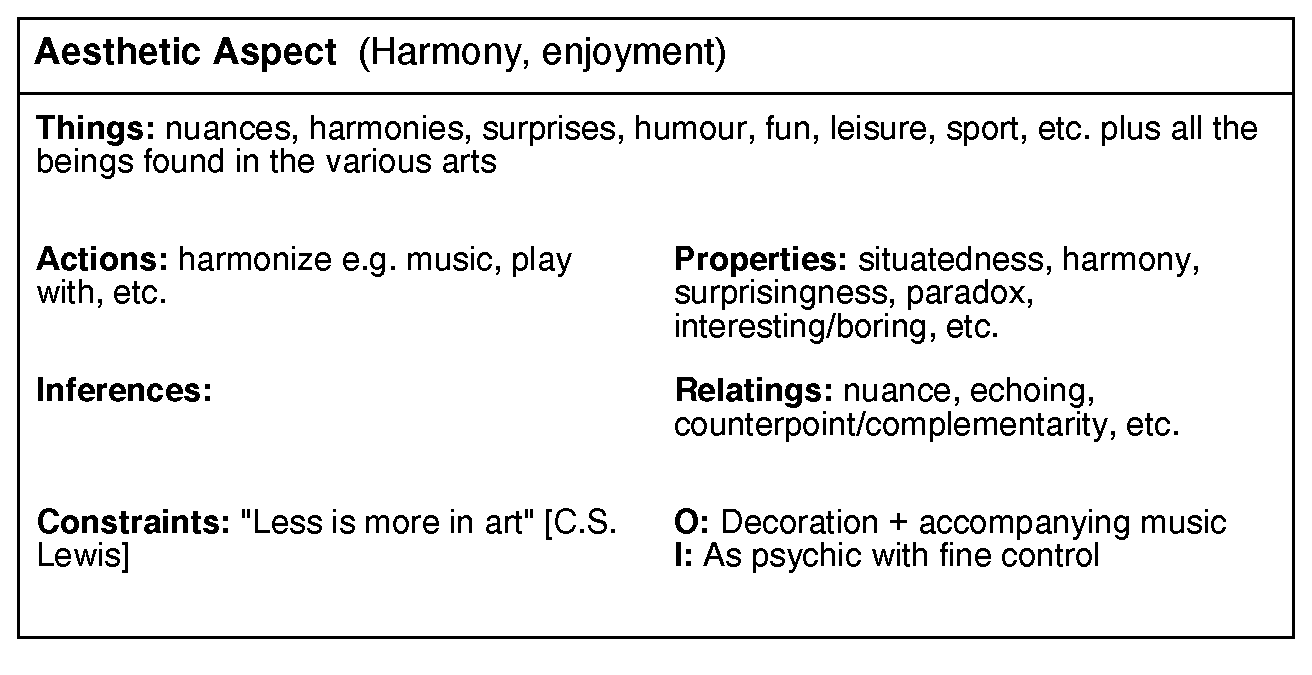
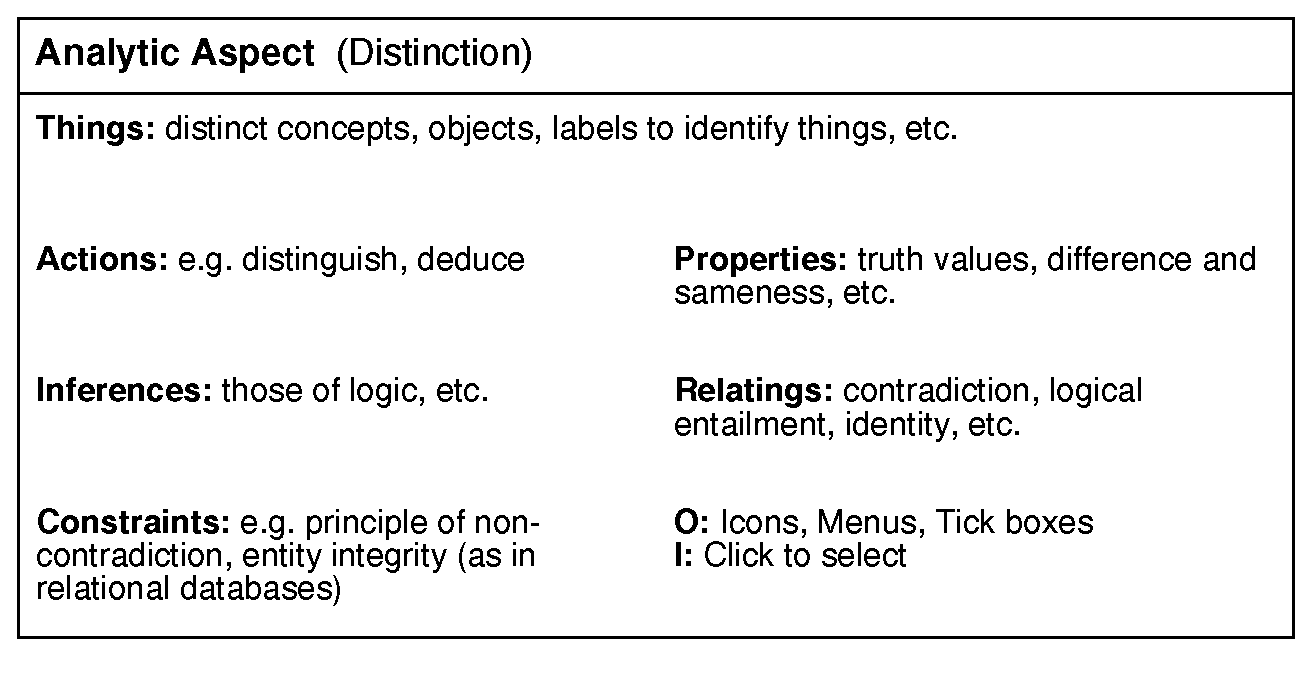

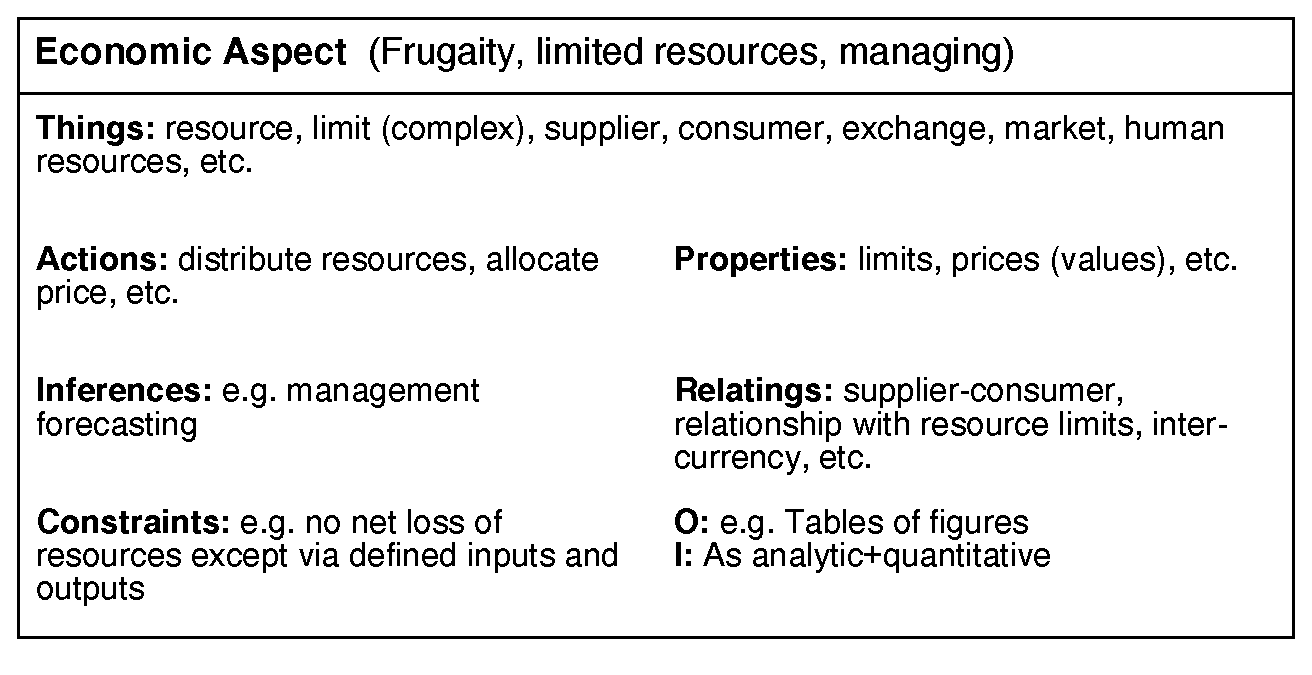
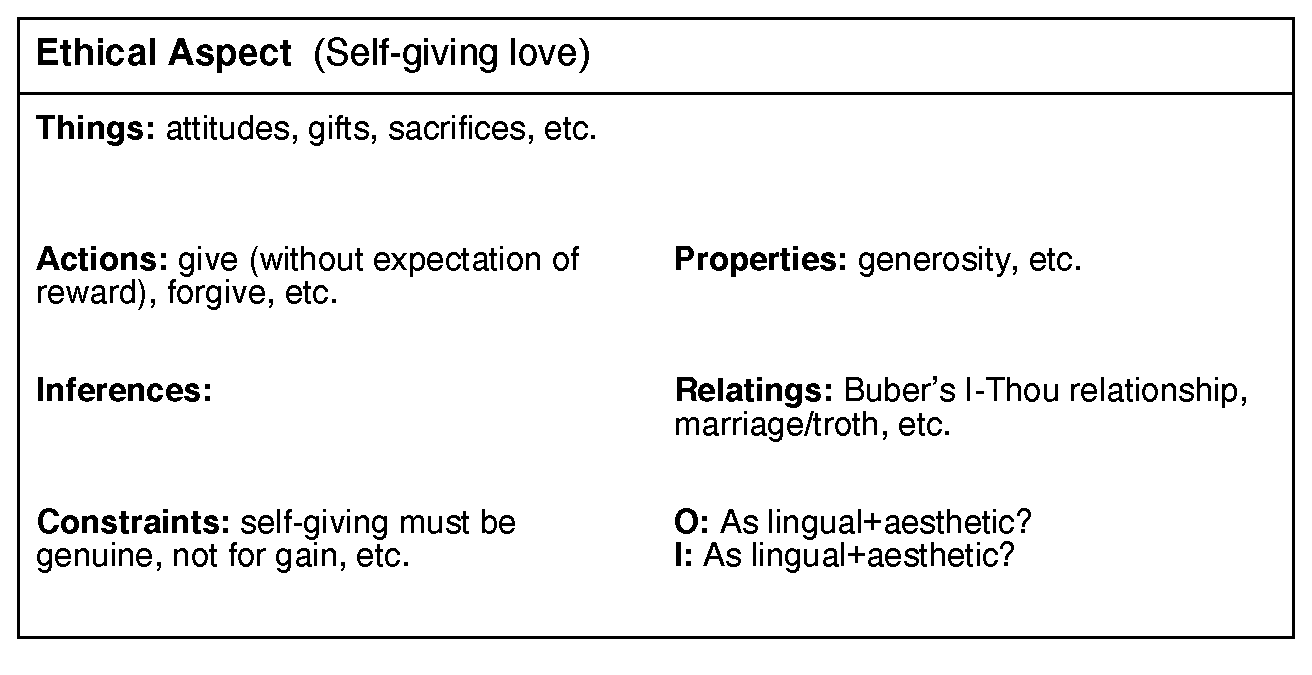
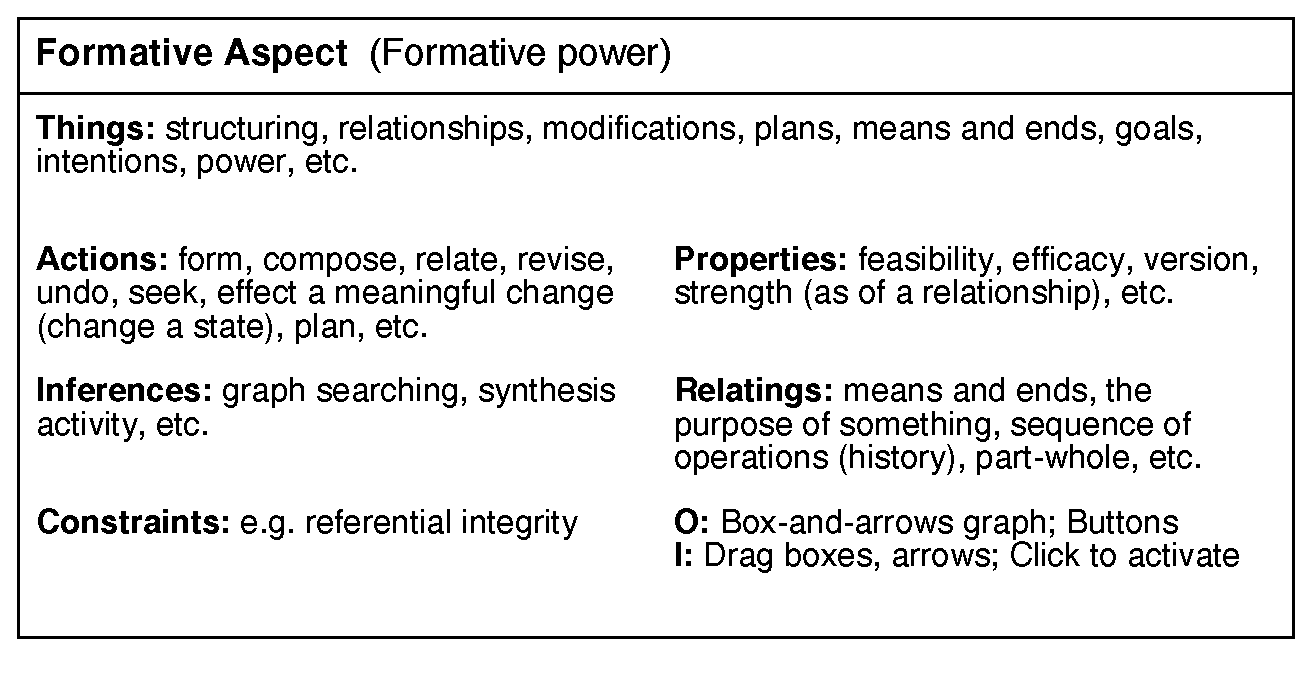
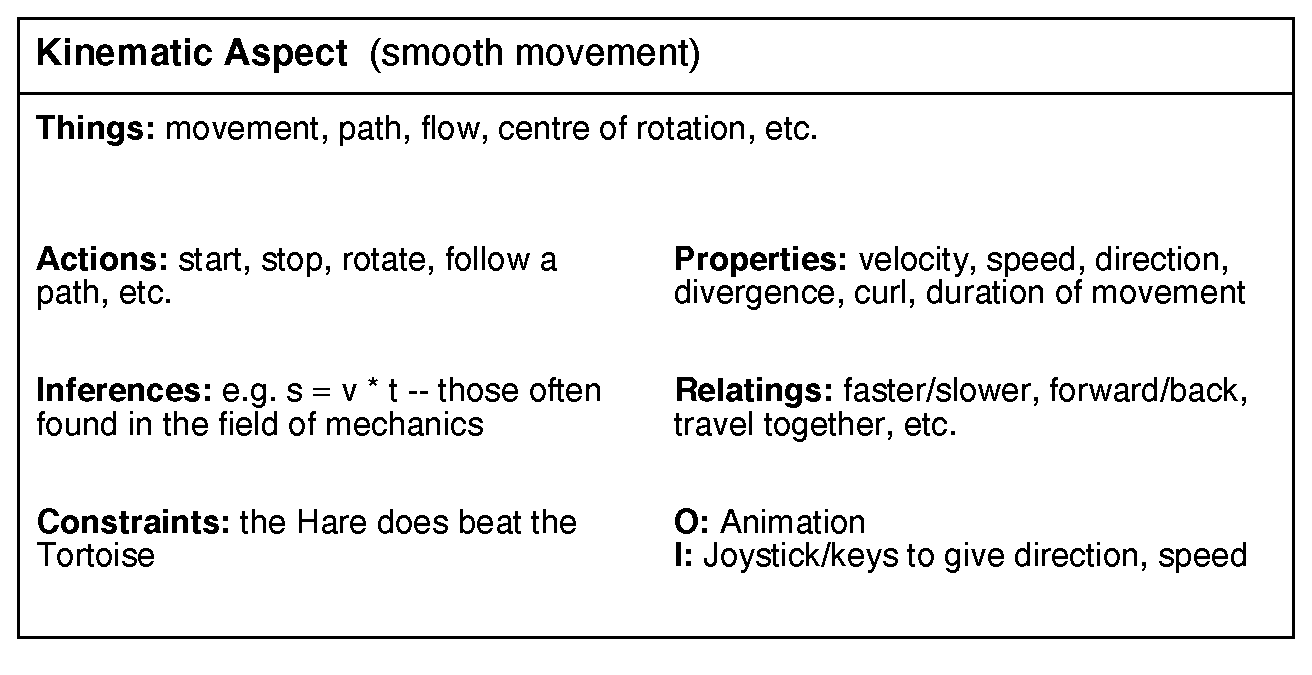
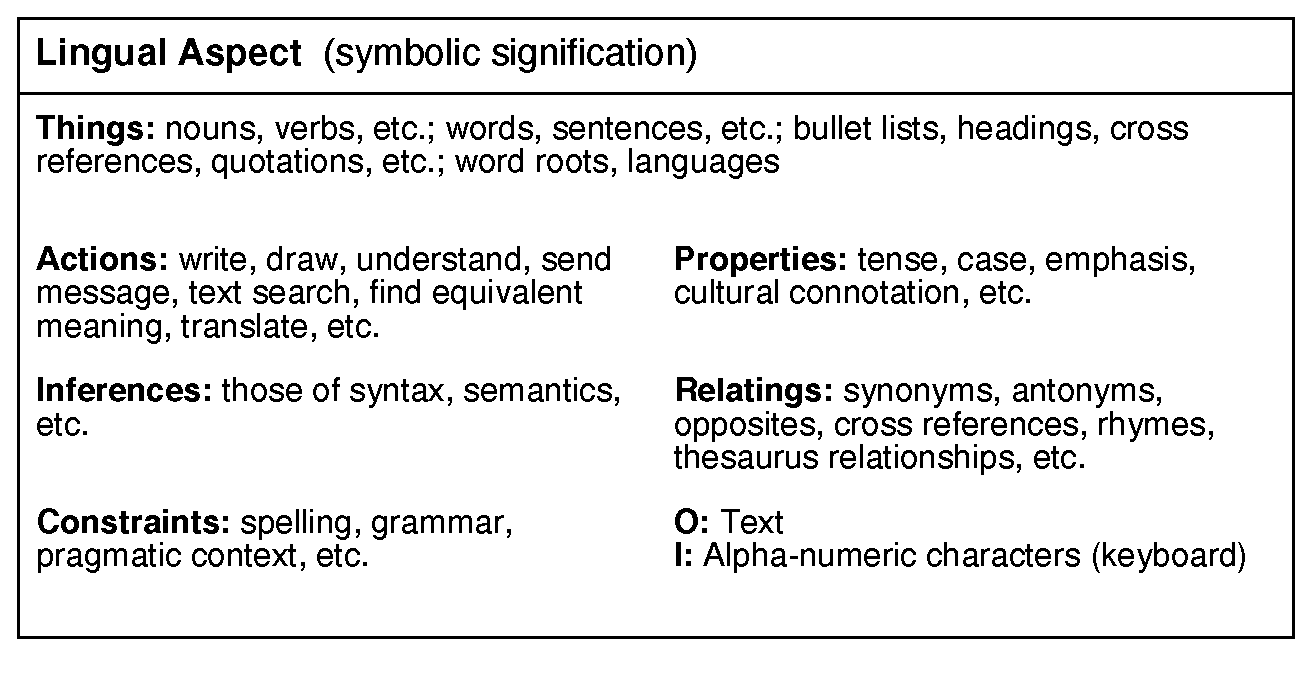
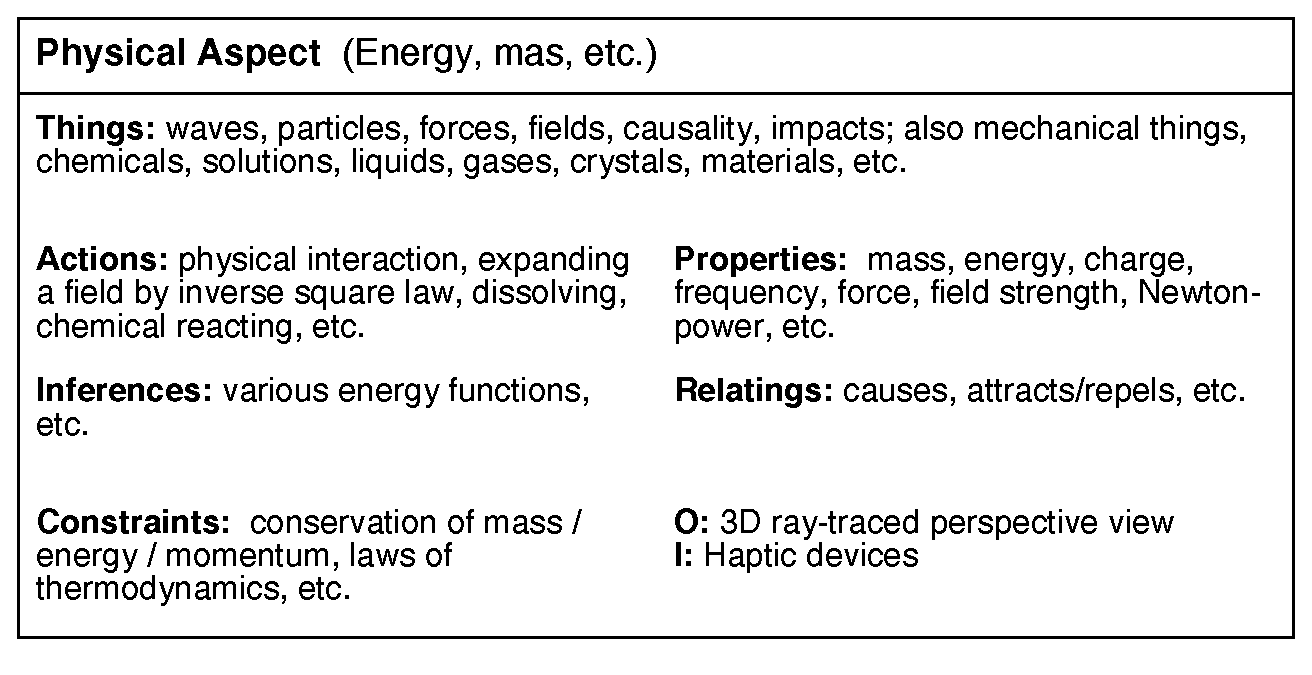
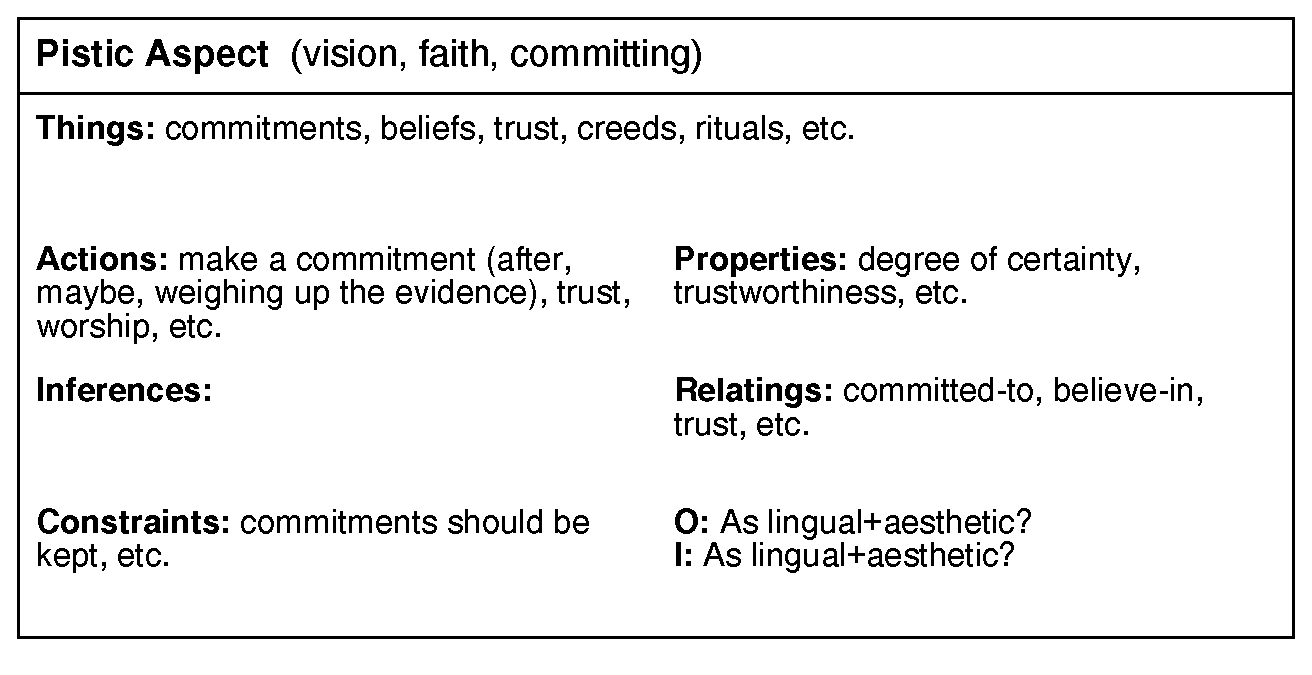
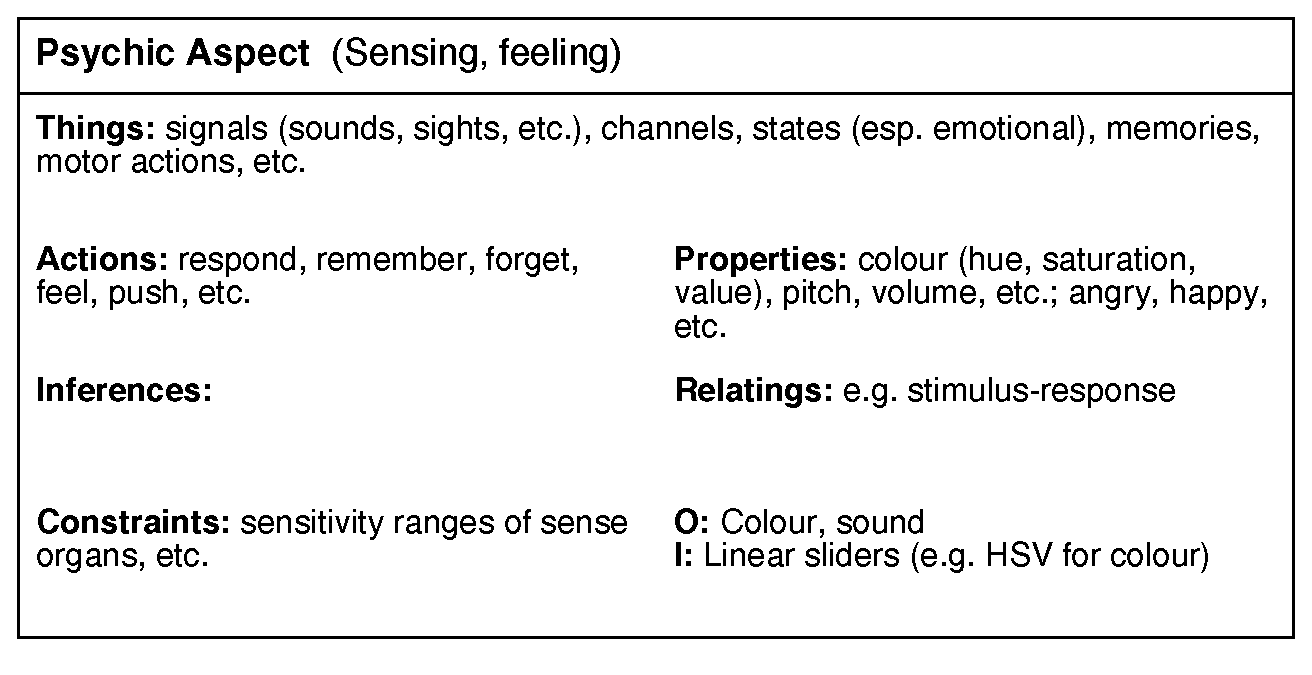
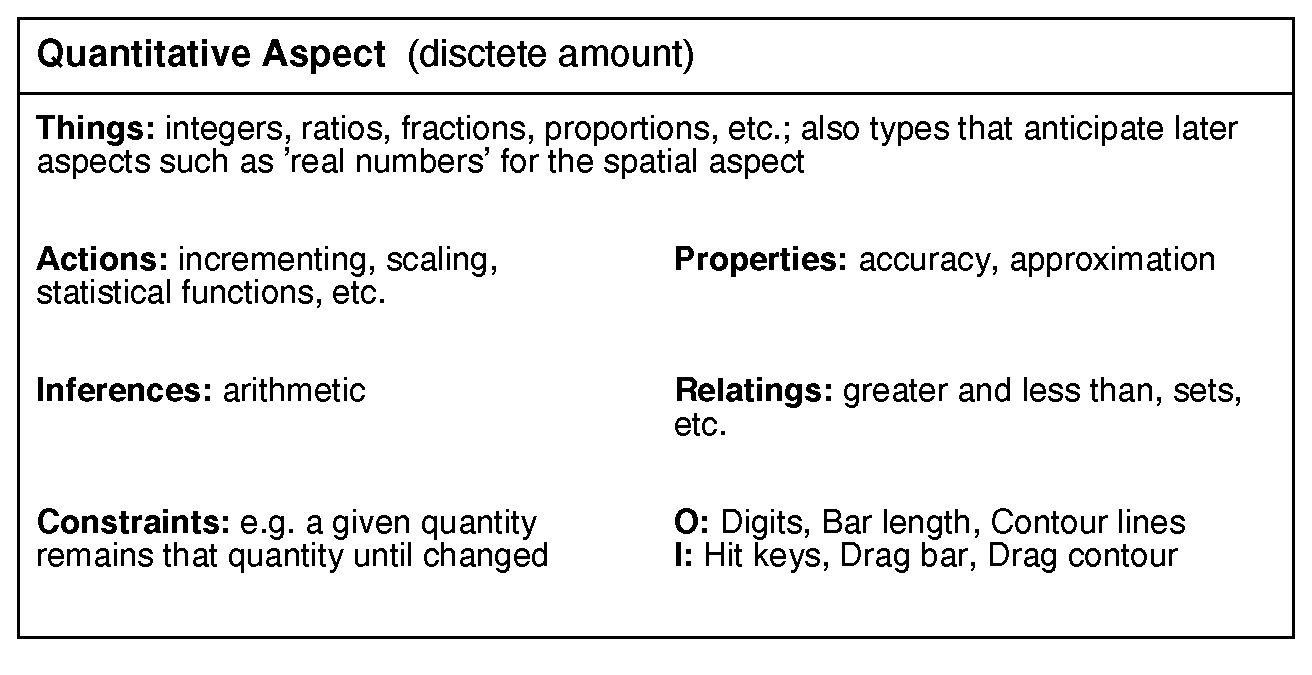
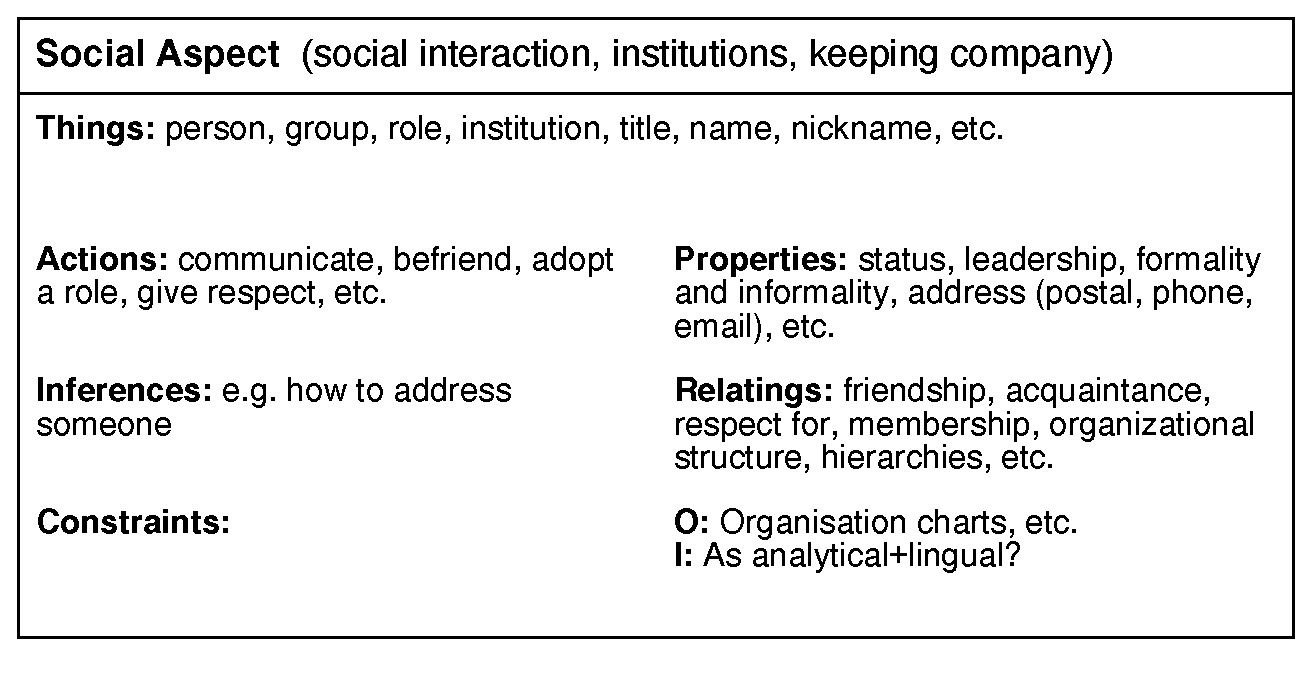
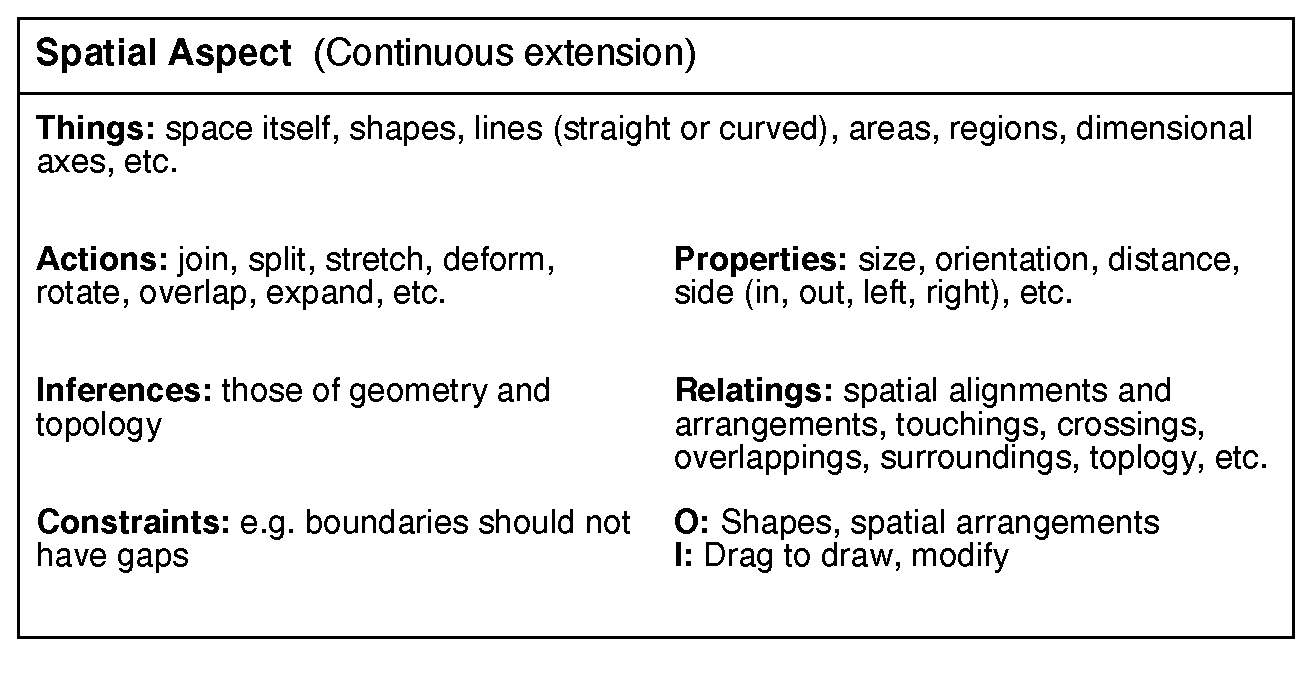

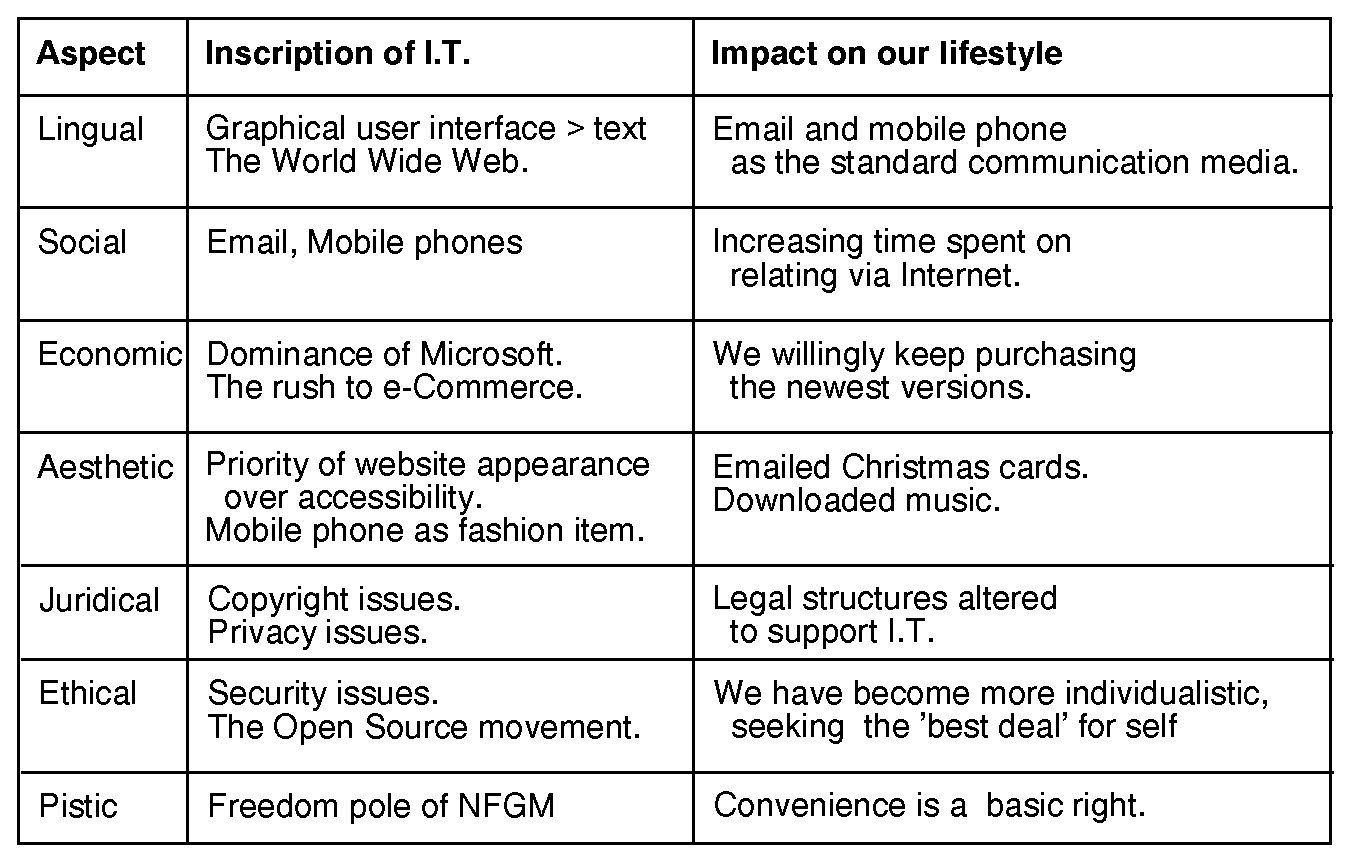
Written on the Amiga and Protext.
Compiled by (c) 2006 Andrew Basden. But you may use this material subject to conditions.
Created: 28 September 2006 Last updated: